A Winter Day

By 6 pm last night it was down to about 18 degrees with light snow falling. The snowfall had caught the city a bit by surprise and the road crews were a bit behind the curve. The National Weather Service issued a winter weather advisory for our area to run through noon today. I had been at the church since early afternoon, but folks who came in for our choir rehearsals reported that there were some slippery spots on the roads and that visibility was reduced. In some rural areas, there weren’t many tracks on the roads and seeing where the edges of the roadways were was difficult in the low light.
In short it was a typical winter day in South Dakota.
A few years ago, my afternoon would have been filled with phone calls about cancelling events at the church, but these days, we pretty much go ahead with our scheduled events as long as the city hasn’t issued a “no travel” advisory. We have dependable all wheel drive vehicles and it isn’t a problem for us to get around. We trust our members to make individual decisions regarding travel. It has been our experience that the older members are used to the weather and tend to get out without much trouble. One member of the choir who is more than 80 years old and who uses a walker to get around came a few minutes early, having allowed extra time for travel.
Like I said, it was a typical winter day in South Dakota.
Our youth group was scheduled for a “Destination Unknown” event. Destination Unknown is a surprise to the youth, but not a secret from their parents. We choose a destination away from the church that helps to illustrate a Biblical principle. Then we plan a visit to the site, a meal and opportunities for discussion. The youth arrive and make guesses as we travel. Sometimes we have specific questions for discussion in the car as we drive. Last night’s Destination Unknown was a visit to a local Indian restaurant with an opportunity to sample the various menu choices and a conversation with the founder and owner, who was born and raised in India, attended college in our town, spent much of his professional career in California, then returned to Rapid City where he now operates two restaurants. The conversation ranged from questions about the country of India, arranged marriage (“It worked well for me. My wife and I celebrated 24 years together last year.”), what it is like to be a Christian in a country where Christians are the minority, the factors surrounding immigration to the United States, and a lot of other topics. All together, the event was a success. The youth were engaged and seemed to enjoy the experience.
However, there was one thing that I noticed. Only one of the youth who participated had a winter coat. None of them had hats, gloves or mittens. Most of them had casual footwear. I didn’t spot any insulated boots. Every one of them would have been chilly if we had needed to spend 15 minutes outside. Some of them would be in serious trouble had we spent an hour out of doors. They assumed that we would have warm cars and our activities would take place in warm buildings. The ones who drove did not expect to need to put on tire chains or change a tire or probably even pump gas into their vehicles. The others assumed that they would be warm and safe while traveling and throughout the evening.
They made assumptions that would not have been made in my youth. We weren’t allowed to take a car out in the winter without a winter survival kit. And we certainly were expected to have dressed warmly and be able to handle minor emergencies on our own. Even decades later, when I traveled with youth in other states, I didn’t have to remind them to have coats, hats, and mittens or gloves for winter events.
In defense of the youth the thing that has changed that insures their safety is that communications are different. Every youth in the group last night had a cell phone and the ability to get in touch with a parent or other adult at every moment throughout the event. Even if there had been a youth without a cell phone, there were enough others who had the devices that they felt secure that they would never be far from a phone.
Still, on a day when a little outdoor activity would enhance health and certainly wasn’t out of the question, none of the youth were prepared to spend any time out of doors at all. Perhaps that fact struck me because I took a little time in the afternoon and loaded our church’s large tandem axle trailer with a couple of cords of firewood in preparation for a delivery on Friday. The snow and cold temperatures didn’t keep me indoors all day. I enjoyed the opportunity to spend some time outside and I appreciated the opportunity to get some exercise in the midst of a day filled with sitting at the computer.
The youth in the group would think of going to a gym for exercise, but going outside might not have occurred to them. Had we had a different mix of youth, there would have been snowboarders and rock climbers and others who love being out of doors. Those youth usually show up with warm hats and jackets and footwear. The particular combination of youth who were able to participate last night turned out to be made of kids who don’t spend that much time out of doors.
I’m old fashioned enough to think that basic safety includes dressing warm enough to spend a little time out of doors. I can imagine plenty of scenarios that might result in needing to be outside and having to wait for assistance or being able to solve a problem without going out of doors. But then I spent the night in my pickup truck in December when it broke down in a very remote location.
So if you’re heading out for your daily activities, bundle up. It’s chilly out there. After all, it is a typical South Dakota winter day.
Copyright © 2013 by Ted Huffman. I wrote this. If you want to copy it, please ask for permission. There is a contact me button at the bottom of this page. If you want to share my blog a friend, please direct your friend to my web site.
The Ads
The advertisers are lining up for the privilege of purchasing those expensive advertisements. And some are paying premium for special spots. Half time ads cost more. Last year an advertisement featuring Clint Eastwood consumed two full minutes of halftime advertising. It got a lot of attention. I guess people are bound to notice when you spend money at that rate. A year later, however, how many people can remember what company was advertised in that commercial? For the record, the company was Chrysler, though I’ve heard people say it was General Motors. It seems to me that part of the goal of an advertisement might be for people to remember which company the advertisement is meant to promote.
But then, I’m no expert at advertising.
There was a time when people found the advertising to be part of the entertainment of the Super Bowl. They would stay glued to their television sets during the breaks just to see what the advertising agencies and companies had come up with. But there is no longer a need to wait until game day to be surprised by the ads. You can already see the advertisements that will be shown during the 2013 Super Bowl on the Internet. No surprises there. The pundits have already chosen their favorites.

Besides, the car dealers in Rapid City pretty much know that I prefer used cars and once I get one I tend to drive the wheels off it before it occurs to me that I might need or want another. They have to sell their top end models and flashy colors to someone else.
I’m pretty sure I’m not a typical viewer of the Super Bowl. I’m likely to turn on the television during the game, but I’m also likely to be doing other things. I often become bored with television and find other activities to do. It is not uncommon for me to become distracted by a project and forget to pay attention to what is going on in the super bowl. A few months from now, I probably won’t remember if Kia or Toyota purchased Super Bowl ads. I’m pretty sure that Coke and Pepsi will spend big on the game as well as Budweiser. None of those companies make much money off of people like me.
I’m just not their target demographic.
But it does make me wonder.

I sort of like the formula that the Frito Lay Company has been using in recent Super Bowls. They run a contest for amateur filmmakers. Two of the best of the submissions run during the Super Bowl. The winner is determined by the USA Today Ad Meter (whatever that is) receives the prize of getting to work with a famous filmmaker on the latest project. There are also cash prizes for the winners. At least they sell a lot of bags of Doritos to amateur filmmakers who try to feature the chips in clever ads. Most of the amateur ads leave no question about what it is that they are advertising.
Well, as you can tell, none of the companies who will be placing ads in this year’s Super Bowl came to me for advice or consultation. I’m just not the kind of person they are interested in impressing. And the way I think is pretty different from the way they think. That’s OK. I don’t have the kind of money that they need to make in order to be able to run ads during the Super Bowl. They have to get that money by selling their products to others.

Copyright © 2013 by Ted Huffman. I wrote this. If you want to copy it, please ask for permission. There is a contact me button at the bottom of this page. If you want to share my blog a friend, please direct your friend to my web site.
The People I Know
The people I hang out with, however, tend to be a bit less perfect. They sometimes curse when they hit their fingers with a hammer. They have a regret or two about things that they did. They can have one or two too many when they get to drinking. They have made an enemy or two, and if not a real enemy, there are at least people who would definitely not describe them as saints.
I guess that I’ve always been drawn to people who are less than perfect. Probably that is because I am less than perfect. It isn’t that I don’t try. I do try. I work hard at making improvements. But I have had some rather negative thoughts about people. I have not connected in the same way with all of those I have been called to serve. I have been exasperated and at my wits end and wished that I simply didn’t have to deal with some of the folks that God sends my way.
Maybe it is some kind of a test. If so, someone has a rather cruel sense of humor.
Maybe it is that we are human.
There are a lot of people who have somewhat skewed notions of the life of a minister. I think that some members of my family don’t really understand who I am or what I do. I don’t want to shock anyone, but I don’t sit around praying all day long every day. I don’t have the Bible memorized. There are some parts of the book that I just don’t get. I am not very pushy when it comes to recruiting new people for the church. I am not very judgmental when it comes to others’ mistakes. Most of the things that other people label as sin aren’t very interesting to me. I think it is perfectly OK for people to have things about them that I don’t know.
I certainly don’t think that I am somehow better than others because I spend a lot of time at church. I spend a lot of time at church because it is a place of deep meaning for me. And one of the most important meanings of the place is that it is a place of forgiveness. It is a place that welcomes people like me.
I once had coffee with a couple that was struggling with divorce. They both had a list of complaints about the other. There had been betrayal and hurt feelings and inattention and mean words and hurtful thoughts and a whole lot of other things in their lives. Neither was innocent. Neither was as bad as their mate made them out to be. But there had once been genuine love. And there was genuine grief over the love that had been lost. And there were children. And there were all kinds of reasons to pursue some kind of relationship – to patch things up in some way – to muddle through “for the sake of the kids.” I didn’t have much advice for them. I am often short of advice. People get themselves into dilemmas from which I do not know the proper escape. But I could listen. And I did. Later one of them told me that the reason they came to church during the long struggle of the breakup of their marriage was that it was the one place in their lives where they could sit next to each other and not be arguing. That’s not a bad reason to have a church, if you think about it. We provide a place where people who are really mad at each other can find a moment of peace while sharing the same space.
I know a man who is a retired bartender. We aren’t the kind of friends who sit and tell each other our stories. I know virtually nothing about his years of sitting in smoky bars, presiding over the drunks and the social drinkers and the smokers and the guys who slipped in to get away from the pressures of their lives. He knows very little about the work I have done or the stories I have been told. I’m not in the habit of telling others’ stories in the first place, though occasionally I use them to illustrate some point or another when I don’t think there is a chance anyone could be identified from my story. But the bartender and I get along as if we were old friends. There is a sense that we understand each other without needing to tell our stories. Maybe I’m a bit like a bartender. A face in the smoky haze who will listen and who knows the value of keeping the story where it belongs.
I think it is possible that we have a mistaken notion of what it is to be a saint. Maybe saints aren’t perfect people in the first place. The song by Lesbia Scott says, “You can meet them in school, on the street, in the store, in church, by the sea, in the house next door.”
It is an intriguing idea. I hardly know the man who lives next door. He lives alone, works nights, and keeps pretty much to himself. We talk in the summer when we are mowing or lawns or working outside on the nice days. We can go a whole winter and not say a word to each other. Recently when he went on vacation for about 10 days I fell into a panic. There was no sign of life at his house and I wondered if he was OK. I’m capable of thinking of all sorts of bad scenarios. I realized that I don’t even know his name or his next of kin. Some neighbor I am. Now that he is back, and appears to be healthy, I resolve to get to know him better. Maybe he is a saint. Then again, I’m not particularly drawn to saints. Perhaps he isn’t a saint and is just the kind of person I’d be honored to get to know.
Copyright © 2013 by Ted Huffman. I wrote this. If you want to copy it, please ask for permission. There is a contact me button at the bottom of this page. If you want to share my blog a friend, please direct your friend to my web site.
Weather
But he was wrong about the weather.
The weather is not an inconsequential topic. Lives are lost to severe weather. The turn of the weather can affect the pattern of ministry. And talking about the weather is a way to make a connection with people. We are all affected by the weather.
Our forecast is for a bit of snow today and tomorrow with gradual clearing throughout the week. By Thursday or Friday we should have generally nice weather. On Friday the highs will be above freezing. It doesn’t sound like much, but we need to get a load of firewood up to the Western end of the Cheyenne River Reservation and it is no fun hauling the big trailer on slippery roads. And I have a busy schedule with a lot of other activities, so I need to plan in order to take a day to haul firewood. Meanwhile, our partners are nearly out of wood. People depend on the wood to keep their houses warm and their propane bills low. How much wood they need is dependent on the weather.
One more example: Yesterday at our annual meeting our congregation voted a budget with a modest surplus. The surplus is on paper and it is likely that we will end the year with that surplus. However, it is entirely dependent upon the severity of winter weather. Colder temperatures mean more heating days and more cost for utilities. And snowstorms mean plowing for our parking lot, which is an expensive proposition.
We are affected by the weather and we ignore it at our own peril.

The weather is worthy of our attention.

I am confident that my teacher would not find conversations about the weather in Australia to be inconsequential or trivial. There isn’t a minister in the nation whose work isn’t affected in some way by the wild weather patterns of the past few years.
The mighty sweep of storms and our inability to be fully prepared for their effects are a reminder that there are plenty of forces in the universe that are more powerful than we. The Bible is filled with references to how storms are evidence of God’s power. “The Lord is slow to anger, and great in power, and will not at all acquit the wicked. The Lord has his way in the whirlwind and in the storm, and the clouds are the dust of his feet.” (Nahum 1:3)
The cycles of drought and flood are seen as signs of God’s power. There are plenty of places in the Bible where severe weather is seen as a sign of God’s judgment. A meteorologist uses different language to describe the weather, but there is a sense of great power in the weather. And we are fascinated by this power. We don’t have cable television at our house, but from time to time I am in a public place where they are showing The Weather Channel. From my limited viewing, it seems to me that that particular channel delights in showing dramatic scenes of wild weather. I think that if one were to watch that channel very much one might get the feeling that severe and devastating storms are the norm in the world of weather.
We notice the storms in part because they are not the norm – they are the exception. Still, when a super storm bears down on your house, you cannot ignore the weather. Perhaps the television shows inspire at least some people to be better prepared.
In a few hours we will be gathering for the funeral of an old friend. The crowd will be small because his circle of friends in this community was small. The weather won’t be a factor in the size of the congregation gathered to mourn together. But the occasion does bring to mind a saying that we often heard when we were pastors in small town North Dakota: “Whether you’re a saint or whether you’re a sinner, the size of your funeral depends on the weather.”
The bottom line is that a lot of things depend on the weather. And we do well to try to understand the forces of this world as we journey through it. May you find strength as you face the storms of life.
Copyright © 2013 by Ted Huffman. I wrote this. If you want to copy it, please ask for permission. There is a contact me button at the bottom of this page. If you want to share my blog a friend, please direct your friend to my web site.
Armchair traveler
Along the top of my shelves is a row of boxes filled with copies of the National Geographic Magazine. I have been a member of the society since 1978. My parents were members and my grandparents before them. I come from a long line of people who have loved travel and maps and stories about far away places.
Today is the anniversary of the founding of the National Geographic Society. It was January 27, 1888 that the National Geographic Society was founded in Washington, D.C. The 33 original members were geographers, explorers, teachers, lawyers, cartographers, military officers and financiers. They all shared the love of travel. Not long after they founded the society they started a magazine. The magazine began as a technical journal with short articles about the details of map making and distant travels. The circulation was very small. But things were about to change. In 1899, the society hired Gilbert Grosvenor to edit its magazine. He quickly changed the format from technical articles to articles of more general interest. But the thing he did that revolutionized the journal was to add the then new technology of photographs. Circulation shot up from 1,000 issues per month to over 2 million in a short period of time.

But the technology is changing. And one has to admit that printed magazines are now rapidly becoming things of the past. There is a National Geographic application for tablet computers and the new retina displays make the pictures more brilliant and realistic than can ever be done with print technology. The Society has remained on the cutting edge of technology, expanding into film, television and now the world of the Internet and social media. You can now own every issue of the National Geographic magazine ever printed on a boxed set of DVD media. Even those will quickly become obsolete. Even smaller storage devices will enable one to have access to the archives. You can already browse through the magazines online if you have a high speed Internet connection.

Cell phones have made everyone photographers and videographers. We carry devices capable of capturing high-resolution video with us wherever we go. Increasingly, our digital lives are becoming more cluttered than our real lives. We used to have a box of photographs that needed to be sorted and put into albums. Now we have tens of thousands of digital images that wait for some indexing and organizing. Even that process is now facilitated by the metadata that is automatically included when we take a digital picture. We can sort our pictures by date or by location without having to do anything. The face recognition software on my computer is getting more and more accurate and I find that using it is becoming nearly as accurate as the names my grandmother used to write on the back of her photographs. Her memory wasn’t always accurate and sometimes she just wrote the wrong names on the photographs. She left behind a legacy of photographs and no small amount of confusion along with them.
It isn’t all bad living at the intersection of the past and the future. I have a large computer monitor on a shelf on my library table. I have a wireless router in my home that gives me access to the Internet in my study. I even have a small television with Apple TV for browsing the Internet and watching YouTube. And the oak telephone operator’s workstation that I salvaged when our small town telephone company was taken over by AT&T now serves as a printer stand where I can make prints of digital photographs when I want them.
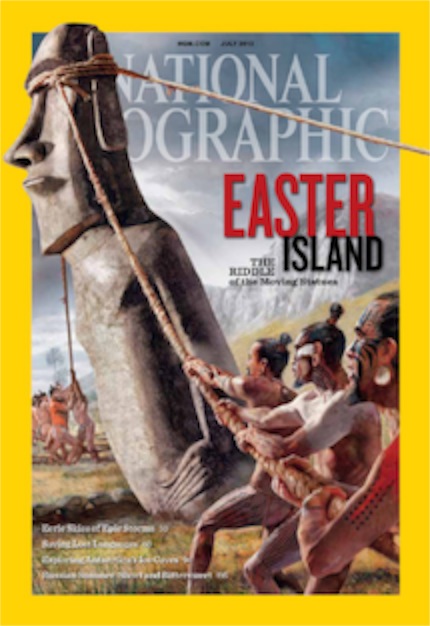
But for now I am comfortable in my study and, when I have a few moments, I enjoy reaching up and taking out an old magazine and reading about a distant place.
Happy Birthday, National Geographic! Thanks for all of the armchair travels.
Copyright © 2013 by Ted Huffman. I wrote this. If you want to copy it, please ask for permission. There is a contact me button at the bottom of this page. If you want to share my blog a friend, please direct your friend to my web site.
Happy Australia Day

225 years ago, on January 26, 1788, the First Fleet arrived in Australia. The agrarian revolution in Britain, and the population explosion in the cities, resulted in an increase in crime. The American Revolution, however, meant that no more convicts could be sent there. So Britain had to look to more distant shores to export its criminals and decrease overcrowding in its jails. The British Government hired 9 ships and provisioned them with enough supplies to keep 759 convicts, their Marine guards, (some with their families) and a few civil officers going until they could become self-sufficient in the new country. The nine ships, with 2 Naval vessels for escort left England May 13, 1787 for the ‘lands beyond the seas’ – Australia. Some of the convicts had been living on the ships for up to 7 months before the actual departure. 23 died during the voyage.
The fleet arrived at Botany Bay between January 18th and 20th, but the area was deemed unsuitable for settlement, so they moved north and arrived at Port Jackson on the Australian East cost on January 26.
The British thought of Australia as being uninhabited and free for the taking. The indigenous people thought differently of that notion. They were wary and fearful of the settlers. The settlers referred to the aboriginals as “Indians.” The name didn’t stick as it had on the North American continent.
The history of relationships between Australian aboriginal people and the settlers has been rocky, not unlike the history between settlers and natives in our land. But the Australians are making progress on the long road toward reconciliation. The government has officially recognized some of the wrongs of the past.

With the history behind the day, there was a symbolic event early this morning that is worthy of note. Around 8am Australia Eastern Daylight Time, before the obligatory family barbecues and citizenship ceremonies were under way across the country, the Aboriginal and Australian flags were slowly raised on the iconic Sydney Harbor Bridge. It was the first time both flags have flown side by side atop the bridge on Australia Day.
Many Aboriginal people see little reason to celebrate January 26. The day is marked as “Invasion Day” in parts of the country. In Hobart, in Tasmania, protestors marched in the streets demanding, among other things, that the day of national celebration be changed to another day – one not associated with the seizure of Aboriginal lands and the displacing of the language, culture, and rights of the indigenous people.
Australia continues to this day to be a land of immigrants. In more than 80 citizenship ceremonies across the land, more than 2,500 new citizens from 92 countries took the pledge and became citizens of Australia. Those prisoners who left England never to return weren’t the only outsiders who came to call the Island nation home.
Most Australians respect and honor this rich diversity. They embrace the gifts that new citizens bring to their land. They enjoy the new foods, new cultures and new languages that daily come to their shores. But it is also a land with tensions. Problems with immigration frequently top the news stories in the land. And there are more than a few Australians who like the fact that the country is not crowded and it can be a hard place to make a living.
Australians have mixed emotions surrounding their national anthem. Like other British colonies, the official anthem was “God Save the Queen.” But the time came when a new song was needed. There were Australians who wanted to stick with the traditional British anthem. Others argued that “Waltzing Matilda” expressed the spirit of their country better. They finally settled on “Advance Australia Fair.” There is a lot of mumbling when Australians sing the song. I’m not too sure how many know the words:
Australians, let us all rejoice
For we are young and free
We’ve golden soil and wealth for toil,
Our home is girt by sea;
Our land abounds in nature’s gifts
Of beauty rich and rare,
In history’s page let every stage
Advance Australia fair,
In joyful strains then let us sing
Advance Australia fair.
Beneath our radiant Southern Cross,
We’ll toil with hearts and hands,
To make this Commonwealth of ours
Renowned of all the lands,
For those who’ve come across the seas
We’ve boundless plains to share,
With courage let us all combine
To advance Australia fair.
In joyful strains then let us sing,
Advance Australia fair.
At least the tune is upbeat. But everyone knows the words to Waltzing Matilda.
Happy Australia Day friends down under! May the journey of your land and people lead to increased respect and reconciliation and peace with the whole world.
Copyright © 2013 by Ted Huffman. I wrote this. If you want to copy it, please ask for permission. There is a contact me button at the bottom of this page. If you want to share my blog a friend, please direct your friend to my web site.
Shaking in Costa Rica
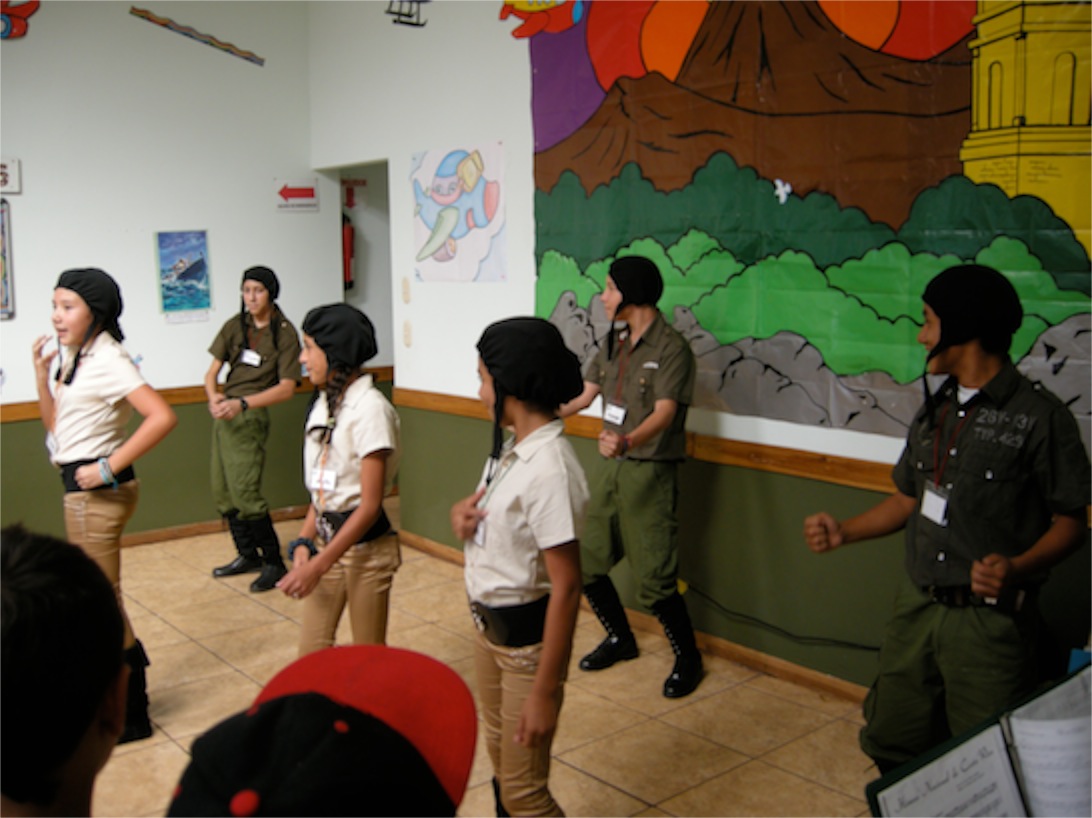
Our congregation has a sister congregation in Costa Rica. I’ve had the privilege of visiting our sister church four times and feel like I have a sense of some of the people who participate in the church. Most of my news from Costa Rica comes from the dedication of a few volunteers who have kept the relationship going. Every year since 1988, our congregation has had lay members visit our sister church, usually during their annual Vacation Bible School, which is in progress this week.
Since we have these Costa Rica connections, I pay a little attention to the news from Costa Rica, mostly by reading the headlines of amcostarica.com and ticotimes.net. The articles don’t have specific information about the people, or even the neighborhoods that are most familiar to me, but Costa Rica is a relatively small country and San Jose is its major urban center, so the news I read has an effect on the people I know.
Sometimes it is interesting to follow stories that have parallels here at home. For example, our newspaper has regular stories about the devastation of pine trees caused by pine bark beetles and the efforts of private and government groups to combat the infestation. In Costa Rica there is a fungus that is destroying coffee crops. The fungus is spreading more rapidly than before in part because the weather has been abnormally warm and dry for a few years. Coffee plants and pine trees aren’t all that similar and the fungus isn’t the same as the beetles, but the sense of needing to manage crops to prevent their destruction is similar as is the sense that the situation may be part of a larger ecological picture.
Among the things I look for as I read the news, especially this time of year when we have members of our church sharing in the VBS down there, are stories about volcanic activity and earthquakes. Central America is filled with volcanoes and seismic activity is a regular part of life there.
I got the news of the earthquake that happened in the wee hours yesterday from an e-mail form our friends in Costa Rica. Later I found a news story about the shaking. A strong earthquake, measuring magnitude 5.2 shortly after 1 a.m. on Thursday, awakened thousands of Ticos. Tico is the local term for a native in Costa Rica. I’m not sure what they call us other than Norte-americano lor perhaps gringo. Chances are that there are other slang terms of reference that would never be used when I was within hearing. Costa Ricans are careful not to openly offend their guests. Even when the answer is “No,” you’ll never hear a Tico say it to you if you are a tourist.
The earthquake felt like two earthquakes to the people in Costa Rica. Seismologists, however, reported that it was a single earthquake with two different seismic waves. There was an aftershock about 20 minutes after the main quake and another about four hours later – all during the time when people would normally be sleeping. It is a little difficult to get a good night’s sleep when the building keeps shaking hard enough to wake you up.
A good night’s sleep is one of the things we pray will occur for our friends in Costa Rica. San Jose is a big city and people have learned to live with a lot of urban noise. Typical sounds of cars and trucks, people living a bit too close together and seemingly ever-present sirens and car alarms make it difficult to sleep for those of us who are used to the natural quiet of the hills. When I have visited Costa Rica, I have found myself waking frequently during the night simply because there are a lot more sounds than I experience at home in the hills.
But the Vacation Bible School team needs a bit of rest. VBS is hectic with a lot of work and a lot of flexibility demanded. Even with capable and energetic youth volunteers, the church is always a bit short of supervision for all of the children and a bit short of space. The adults who participate have to focus their attention to keep track of all of the activity and keep the program running according to plan. And our volunteers have the added challenges of working in a second language while trying to keep track of the names of the children which are every bit as confusing as the names given to children in the USA these days. Add to that a lot of walking – it is really necessary to get things done in the city. The result is tired volunteers. They give freely of their time and energy, but Costa Rica and our sister church seem to be capable of absorbing all of the time and energy you have.
Each day begins with a prayer of thanksgiving for the dedicated volunteers who are so generous with all of their lives. The connection between the two congregations is essential to the health of our congregation in Rapid City. A church can’t be a church if it focuses only on its own needs and concerns. To be a church requires constant outreach and connection with the needs of the world. Engaging with the concerns of the world and serving the wider community are at the heart of what it means to be a church. Without a strong sense of mission, congregations quickly deteriorate into social clubs and the busy people of our community have little time for social clubs.
It may be true that our Costa Rica sister church has grown a bit dependent upon the financial support from our congregation. But it is equally true that our Rapid City congregation has become dependent upon the work of our Costa Rica congregation. Feeding hungry people, witnessing for hope and faithfulness in a challenging environment, supporting education and reaching out to those with no church connections are all critical to our identity as Christians. The two congregations need each other in order to be complete.
So I read the news from Costa Rica every day. I pray for the people of Costa Rica every day. They are not far away. What happens to them happens to us. As I say over and over again, “We’re all in this together.”
Copyright © 2013 by Ted Huffman. I wrote this. If you want to copy it, please ask for permission. There is a contact me button at the bottom of this page. If you want to share my blog a friend, please direct your friend to my web site.
We're All in This Together
- Birth to roughly age 7 is the imprint period. We are like sponges, absorbing everything around us and accepting what happens to us a s true, especially when it comes from our parents. We assume that what happens to us is normative.
2 Between the ages of 8 and 13, we copy others. Massey calls this the modeling period. We not only copy our parents, but also copy other significant adults in our lives. Rather than blind acceptance, we try on ideas and values to see if they fit. Some ideas and values are rejected and others are kept.
3 Massey calls the time between ages 13 and 21 the socialization period. In those years we are deeply influenced by our peers. We develop our own individual values and differentiate between own values and the influences of earlier life. We turn to people who seem most like us in search of models.
Like other models of the socialization process, Massey’s view is overly simplified. Real people don’t have ridged turning points as they transition from one stage to another. There are all sorts of life experiences that can change development, including the failure to develop basic trust in early childhood. However, his ideas have some truth in them that has been useful as I work with the people I encounter in the church.
One of the things that I have noticed are variations in how someone grieves the loss of a parent is quite dependent upon their age.
I was 27 years old when my father died. It was not my first experience of death in my family. We had lost a sister when I was 16. My paternal grandfather died when I was 19. My maternal grandmother died before I was born. My maternal grandfather died when I was 2. My father’s death was not sudden. His cancer diagnosis gave him and us an opportunity to prepare. He was a practical man and spoke frankly of his illness and his death and helped us to make plans that served us well. My mother was able to live comfortably as a widow for more than 30 years after he died, due, in a large part to successful planning and management of resources.
But I have been with children and teens at the point of the death of a parent. I have been called upon to deliver the news of the death of a parent to those in their middle years. I remember clearly a funeral where the surviving daughters were well into their seventies.
I have been thinking of a young man that I have known for many years for whom the decade of his 40s has been a decade of grief. I don’t know all of the details of his life, so he may have experienced the loss of grandparents, aunts, uncles or cousins earlier, but his paternal grandparents, two brothers who were his only siblings, and his father all have died in the past decade. He has no children of his own, so as his 50’s birthday looms, there aren’t that many people in his life left to lose. His mother is still living. Although he has never been formally married, he has a significant and long-term relationship with a partner. Going by the numbers, however, he doesn’t have enough people in his life for his 50s to have the amount of loss he has experienced in his 40s.
He was 14 when I met him and I still see him as a young man, but yesterday a casual observer might have said that he was much older than his real age. He was tired and worn not just be the realities of life and a long drive to take while managing his business from a distance. He was worn by the emotional stress of too much grief in too short of a time. Massey got that much right. What you are is where you were when. He was in the middle of the building years of his career struggling to earn a living and build up a business when he was struck by loss after loss after loss. Retirement is still many years away for him, but between now ant that time, he will need to invest significant energy in forming new relationships and filling his life with new people. He now embarks on psychological and social tasks that for some are relegated to their teens and twenties. But he does so with a load of grief and wariness about the pain of loss that is seldom known by younger people.
There are times when I can get to feeling that my course in life has been difficult. But it doesn’t take much observation to discover those whose lives have been much more challenging and whose losses have been much more painful.
I frequently tell people, “You don’t get over the loss of the people you love. You can survive loss. You can even thrive after a loss. But you don’t get over it. The loss stays with you forever.” Fortunately, I have been allowed to witness people of great strength and character who have not only survived loss, but have used the experiences of grief and loss to temper their character and become more compassionate, caring and loving. I never pray for people to forget their grief. I do, however, pray for them to come to peace with their loss and to grow through their pain.
The phrase, “We’re All in This Together” has been used in many different places in popular culture. It is a song and dance routine from the movie High School Musical. It is a phrase in a Hillsong United film. It is the title of a collection of short stories by Owen King and a catchphrase on the Red Green show. It is also the truth. We are all in this together. We haven’t all had the same experiences. Our live journeys are vastly different. But we are all in this together. My life is shaped not only by the prayers of the young people who gathered for youth group in our church last night, but also the prayers of the adults who were members of the youth group I served 35 years ago and all of the youth-become-adults with whom I have shared the journey in between. We are all in this together.
Copyright © 2013 by Ted Huffman. I wrote this. If you want to copy it, please ask for permission. There is a contact me button at the bottom of this page. If you want to share my blog a friend, please direct your friend to my web site.
There is more to the story
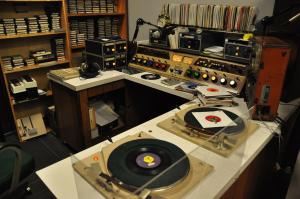
But I have known from those days that despite the popularity of the show, “The Rest of the Story” is never the whole story. News reporters and entertainers (I’m not sure which category best described Paul Harvey) make decisions about what to say and what to leave unsaid. There is never enough time on air and never enough attention from the audience to truly tell a complete story. Reporters are constantly making decisions about what to say and what to leave unsaid.
Some things come instinctually. If you live in a small town, you report the tragic loss of an individual in a car accident, but you probably don’t go into the details of the night of heavy drinking that preceded the accident. You tell about the sale of a herd of livestock, but you don’t dwell on the series of bad decisions that forced the sale. You cover the winners of the school board election, but don’t go into the backroom meetings where a potential candidate was intimidated and “persuaded” not to file a petition to get on the ballot. You report on the new public official, but don’t go into the scandal that preceded the rapid departure of the previous person in that position. After all, you have to live in that town, too. The people who listen to the radio are your neighbors – and in my case the members of my congregation.
There is always more to the story, even when Paul Harvey declares, “And now you know the rest of the story.”
Sometimes I am called upon to tell part of the story of a person’s life. I deliver a dozen or more eulogies every year. Some of the eulogies are for people that I never met face-to-face. Sometimes it is someone whose life I have witnessed for a long time. Last night I held the head of a man I first met 35 years ago as the staff of the funeral home gently laid him on a stretcher to transport his body for preparation for the funeral. I was on my way when he died. I arrived a few minutes after it was over. I have watched as he declined and visited nearly daily. I had been with him less than 12 hours before he died. Still, there is something very final about those moments as you sit with a body and wait for what is to come next.
His widow asked a few questions about the obituary. I started to think about how I would craft the words for his funeral. I’ll be perfectly frank. I know things that have no place in a funeral service. I’ve witnessed moments that I wish I could forget. This man was, like the rest of us, full of brilliance and capable of making bad decisions; brilliant in some moments and stupid in others; compassionate and insensitive at the same time. In a word, he was like all Christians: forgiven.
My work is now focused on a grieving family that, like all families, is complex. A son may not have the same needs as an ex-wife. A brother and sister may disagree or have witnessed different parts of the story. There are some old emotions that appear like landmines on the road of grief. There is unfinished business that needs to be resolved in a less-than-perfect manner.
In the old days, when I finished my on-air shift at the radio station, I would walk down to the City Café to have a cup of coffee and hear the stories of the folks who gathered there every morning. On my way, I’d walk past the office of the man who died last night. We’d often walk to the café together and sit in the same booth. For our town, the real “rest of the story” was never broadcast on the radio – it was learned informally over a cup of coffee.
Whenever the funeral is planned, I won’t be telling the whole story. But I also won’t be pretending that I am some kind of impartial observer. I’ve been a character in the story for 3 and a half decades.
Fortunately I proclaim God who is so invested in our human lives that he became one of us to walk alongside us, to share our common lot and also to conquer sin and death.
Despite everything else, Love wins.
Copyright © 2013 by Ted Huffman. I wrote this. If you want to copy it, please ask for permission. There is a contact me button at the bottom of this page. If you want to share my blog a friend, please direct your friend to my web site.
A Nation Prays
There we were, the President and Vice-President, the Supreme Court and the members of the Senate and House. Republicans and Democrats gathered together. There were plenty of spectators gathered in that place that is so rich in history and meaning. And there were a lot more watching on television. I was listening on the radio. As I pulled into my driveway after taking items to be recycled, I stopped and listened as the nation paused to pray together. I joined in the prayer.
Myrlie Evers-Williams became the first laywoman to give an inaugural invocation. Evers-Williams is the widow of civil rights leader Medgar Evers, who was killed by a white supremacist 50 years ago. I have worked much of my career to promote the leadership of lay persons and to encourage lay leaders to lead prayers, so it was a small moment of personal satisfaction for me to know that the entire nation was seeing a direct example of a layperson leading prayers. I can remember those tumultuous years of the early 1960’s as the struggle for civil rights was so visible before the entire nation. Now, 50 years later we were all invited to pray together.
I am aware that there has already been a lot of criticism of the choice of Evers-Williams and of the prayer she offered. I read Politico and Huffington Post blogs. But I am not one to quickly attack a prayer or the person offering it. I know that God hears and answers prayers even when the one offering it is not worthy. I know that God hears and answers prayers even when the choice of words is not perfect. I know these things from direct experience. I offer prayers every day. Some of the most powerful moments of prayer have come when I don’t have the right words for the occasion. Sometimes “God help us!” or “What should I do?” are the most heartfelt prayers one can offer. Sometimes I don’t have any words at all.
But I also know the power of knowing that you are not the only one who is praying. Yesterday, we prayed together.
We ought to do that more often.
These are the words of Myrlie Evers-Williams. May we refrain from our partisan bickering and refrain from our attacks and criticisms enough to simply pray together as a nation.
America, we are here, our nation’s Capitol on this January the 21st 2013, the inauguration of our 45th [editor’s note, should be 44th] president Barack Obama. We come at this time to ask blessings upon our leaders, the president, vice president, members of Congress, all elected and appointed officials of the United States of America. We are here to ask blessings upon our armed forces, blessings upon all who contribute to the essence of the American spirit, the American dream. The opportunity to become whatever our mankind, womankind, allows us to be. This is the promise of America.
As we sing the words of belief, “this is my country,” let us act upon the meaning that everyone is included. May the inherent dignity and inalienable rights of every woman, man, boy and girl be honored. May all your people, especially the least of these, flourish in our blessed nation. One hundred fifty years after the Emancipation Proclamation and 50 years after the March on Washington, we celebrate the spirit of our ancestors, which has allowed us to move from a nation of unborn hopes and a history of disenfranchised [votes] to today’s expression of a more perfect union. We ask, too, almighty that where our paths seem blanketed by [throngs] of oppression and riddle by pangs of despair we ask for your guidance toward the light of deliverance. And that the vision of those that came before us and dreamed of this day, that we recognize that their visions still inspire us.
They are a great cloud of witnesses unseen by the naked eye but all around us thankful that their living was not in vain. For every mountain you gave us the strength to climb. Your grace is pleaded to continue that climb for America and the world. We now stand beneath the shadow nation’s Capitol whose golden dome reflects the unity and democracy of one nation, indivisible with liberty and justice for all. Approximately four miles from where we are assembled the hallowed remains of men and women rest in Arlington Cemetery. They who believed, fought and died for this country. May their spirit infuse our being to work together with respect, enabling us to continue to build this nation, and in so doing we send a message to the world that we are strong, fierce in our strength, and ever vigilant in our pursuit of freedom. We ask that you grant our president the will to act courageously but cautiously when confronted with danger and to act prudently but deliberately when challenged by adversity. Please continue to bless his efforts to lead by example in consideration and favor of the diversity of our people.
Bless our families all across this nation.
We thank you for this opportunity of prayer to strengthen us for the journey through the days that lie ahead.
We invoke the prayers of our grandmothers, who taught us to pray, ‘God make me a blessing.’ Let their spirit guide us as we claim the spirit of old.
There’s something within me that holds the reins. There’s something within me that banishes pain. There’s something within me I cannot explain. But all I know America, there is something within. There is something within.
In Jesus’ name and the name of all who are holy and right we pray. Amen.
Copyright © 2013 by Ted Huffman. I wrote this. If you want to copy it, please ask for permission. There is a contact me button at the bottom of this page. If you want to share my blog a friend, please direct your friend to my web site.
Honoring the Dream
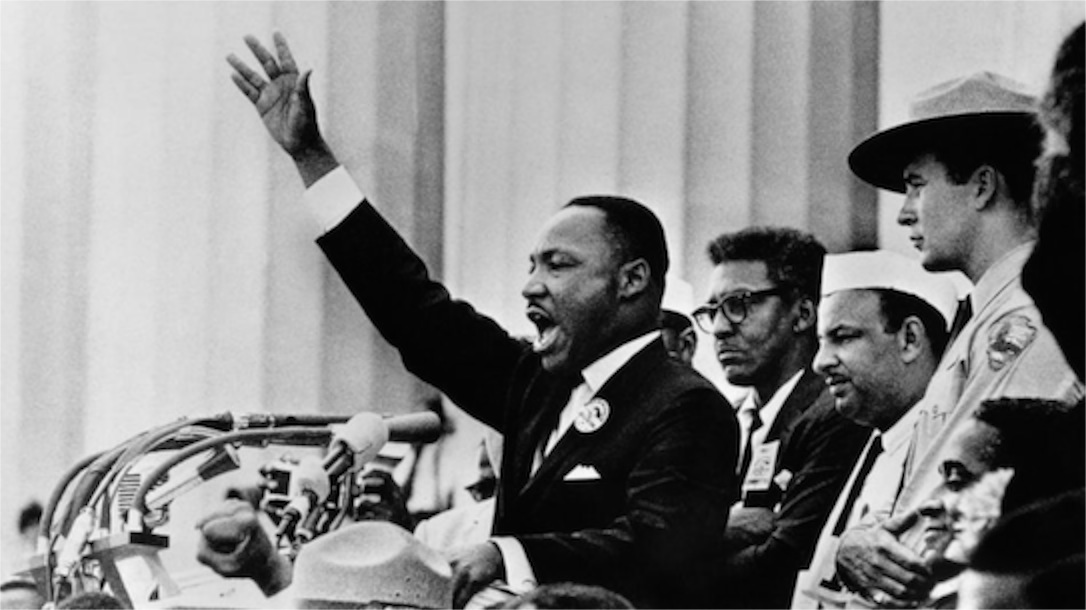
I struggle with how to mark Martin Luther King Day. Today is the only official US government holiday devoted to a single individual. And it is appropriate that such a holiday be devoted to the most admired American of the century. According to a Gallup poll, no American of the 20th Century was more admired than Dr. King. Only Mother Teresa scored higher. More admired than John F. Kennedy, more admired than Albert Einstein, more admired than Helen Keller, Dr. Martin Luther King, Jr. led a movement that changed American history.
But, sadly, we have not lived up to that legacy. “I have a dream,” Dr. King said in his famous 1963 March on Washington speech, “I have a dream that my four little children will one day live in a nation where they will not be judged by the color of their skin but by the content of their character.”
It is a noble dream. It is a dream that remains unfulfilled. Even with an African-American President the dream remains unfulfilled. Even with famously rich African-Americans like Oprah, Michael Jackson, Tiger Woods and O.J., the dream remains unfulfilled. We do not live in a color-blind society. We are no immune from racism.
Dr. King was successful in changing the attitudes of society. And his movement was successful in changing some of the laws that expressed institutional racism. And the doors have been opened to admit a few persons of color into positions of power and wealth. But we have such a long way to go.
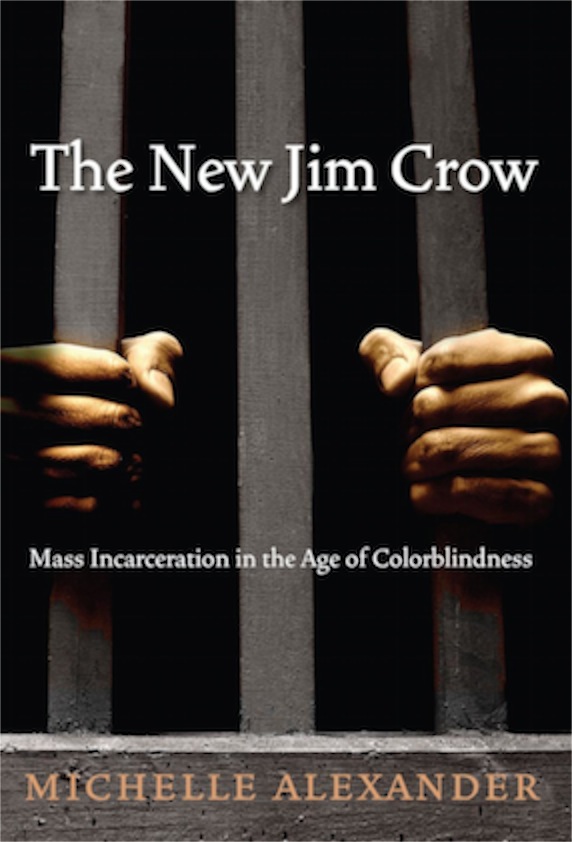
We would like to believe that everyone in prison is there because they have broken the law and are a threat to society. We would like to believe that our justice system is colorblind and that it makes no difference what your race is when you appear before a judge. The statistics simply do not support that view, however. The book systematically presents a very compelling argument that demonstrates how each stage in our criminal justice system has operated to the detriment of African-Americans.
I didn’t need to read the book in order to know that we have not eliminated racism from our society. I live in South Dakota where the population in our prisons is disproportionately Native American and our incarceration rate is nearly double that of neighboring states. I am painfully aware that our state legislature passionately debates laws funding education and falls far short of our neighbors in support for schools while the budgets for prisons sail through the legislature and increased funding for prisons is seen as a higher priority for state moneys than education in every session of the legislature. I listened carefully to our Governor as he outlined the recommendations of a program of judicial reform and told us how he had carefully limited the proposals to eliminate any possibility of innovation by requiring the committee to consider only laws and programs that had been adopted by other states. Far too many of those “reform” proposals come directly from Southern states with extremely high incarceration rates.
But you wouldn’t have to even know about our state government or visit our prisons to know that racism is alive and well in South Dakota. A quick tour of the neighborhoods and schools of our city makes it clear that we have a caste system in our town.
So I struggle with how to recognize this day. I am impressed with the President’s call to public service in recognition of Dr. Martin Luther King, Jr. It is a fitting tribute. Volunteerism can make a big difference and service is certainly a pathway that should be encouraged. Public commemorations are appropriate. Faith Temple Church in our town is hosting the annual Dr. Martin Luther King Jr. Day Community Celebration at the Rushmore Plaza Holiday Inn Ballroom at noon today. I have attended many of the celebrations in the past and have participated in our public celebrations. But there is little in such an event that inspires genuine change. This year’s theme is “Honoring the Dream.” But I know from prior experience that the program will not include a call to make serious structural changes in our way of life.
I don’t know if we honor the dream by arguing for the status quo.
It seems to me that perhaps this is a day for some introspection and internal wrestling for me. In what ways does my life foster the growth of racism? How have I bought into a system whereby I benefit from the sufferings of others? When have I failed to work for justice for all of the people of this great land?
One of my disciplines for 2013 is to read a poem by Rilke each day. So you can expect a lot of Rilke quotes in this year’s blogs. Today’s poem strikes me:
The Man Watching (II)
What we triumph over is so small,
and the victory makes us small too.
The eternal and uncommon
refuses to be bent by us.
Like the angel who appeared
to the wrestler in the Old Testament;
when his opponent’s sinews
grow hard as metal in the struggle,
they feel to his fingers like strings
on which to play a depthless melody.
Whoever is conquered by this angel
when the angel does not refuse to fight
walks away erect and ennobled,
strengthened by that fierce hand
that, like a sculptor’s, shaped him.
Winning does not tempt that man.
His growth is this: to be defeated
by ever greater forces.
Book of images
So I continue to wrestle with myself and my own attitudes. We have come a long way, but the journey ahead is no less daunting.
The dream calls us to a new future.
Copyright © 2013 by Ted Huffman. I wrote this. If you want to copy it, please ask for permission. There is a contact me button at the bottom of this page. If you want to share my blog a friend, please direct your friend to my web site.
A eulogy and a lesson in physics
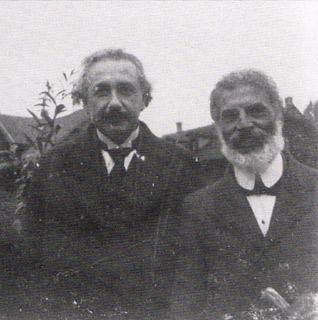 I’ve been looking to read the entire text for a variety of reasons. I am called upon to deliver eulogies on a relatively regular basis and I want to do a good job of serving the needs of grieving families. Reading eulogies is one way to strengthen my skills at writing them. I also have a special interest in the thinking of Einstein. He was an obviously brilliant thinker who pushed our understanding of the nature of time and space. He expanded our understanding of the universe in which we live. We still don’t understand completely, and perhaps never will, but we understand a little more. And I understand only part of what Einstein taught.
I’ve been looking to read the entire text for a variety of reasons. I am called upon to deliver eulogies on a relatively regular basis and I want to do a good job of serving the needs of grieving families. Reading eulogies is one way to strengthen my skills at writing them. I also have a special interest in the thinking of Einstein. He was an obviously brilliant thinker who pushed our understanding of the nature of time and space. He expanded our understanding of the universe in which we live. We still don’t understand completely, and perhaps never will, but we understand a little more. And I understand only part of what Einstein taught.I have a member of my congregation who thinks that it is funny every time I make a reference to physics in one of my sermons. He is even more amused when I try to explain a concept from my layperson’s point of view. He is a brilliant doctor and I am sure that he understands much more of quantum physics than I, but I also know that the theories of physics are always a stretch of thinking for our minds and they are only one framework for explaining the world around us. I once read that contemporary astrophysics is able to directly observe only about 3% of the known universe. This means that the “study” is highly based in speculation. It is rational speculation, but speculation nonetheless. Regardless of whether or not the 3% is accurate, it is true that we know only a tiny bit of the nature of the universe. We try to be consistent in our thinking as we push the boundaries of our understanding, but when we are honest, we admit that even the most brilliant among us understands only a tiny fraction of what this universe is and how it works.
I have also been searching for the entire text of the eulogy because I know that there are many different ways to think about time and space. We have been raised with a three-tiered framework for evaluating the passage of time. We think of time as past, present and future. Moments quickly pass. By the time you read this blog, the moment of my writing it will be past. As I am writing it, the moment of your reading it remains in the future. So even this blog is not seen from the same perspective by you as by me.
That is part of what Einstein was trying to say on the occasion of the death of his friend Besso. The quote from that eulogy that I do have is this: “Now Besso has departed from this strange world a little ahead of me. That means nothing. People like us, who believe in physics, know that the distinction between past, present and future is only a stubbornly persistent illusion.”
In the midst of his grief, Einstein refers to physics as a framework of belief, he refers to it as if it were a religion. “Those of us who believe in physics,” makes his statement a sort of parallel argument to the quote from Thessalonians that I often say at the time of the committal of human remains: “For since we believe that Jesus died and rose again, even so, through Jesus, God will bring with him those who have fallen asleep.” (1 Thessalonians 4:14) The book of Thessalonians and Einstein’s explanation of time are both statements of belief.
More fascinating to me than thinking of Einstein as a man of faith, which in contrast to some atheists, I do, is the thought of Einstein challenging us to think of time in a different manner.
I have heard the story of the young Einstein, riding to work in Bern, Switzerland, watching the famous clock tower as he passed. He was speculating on the nature of time and suddenly he thought that if one were able to travel away from that clock at the speed of light, while still being able to observe the clock, the clock from the perspective of the one traveling would remain constant – not changing time at all, while time would pass for the traveler. The thought opened to Einstein a new way of thinking of the relationship between time and space and eventually led to his breakthrough thinking that opened up a new way of understanding physics. The theory of the relativity of time has since been directly observed by using highly accurate timepieces. One clock travels in a fast vehicle such as an airplane or a rocket while the other remains static. There is a measurable difference in the passage of time. Every time I try to explain this principle, I get myself a bit confused, but I know that time appears differently depending on one’s perspective.
To a physicist, then, a moment has both the property of quickly passing and also the property of continuing to exist when viewed from a vastly different perspective. To a quantum physicist each moment continues to exist perpetually in some different dimension. Therefore no moment is ever truly “past.”
I’m not sure how much consolation this perspective is to one who is grieving. For the pain of loss is real. Even if every moment of togetherness exists forever in some dimension of time-space reality, so too does the moment of recognition of separation. Knowing that past moments are not truly past, but on-going doesn’t change the reality of loss.
The bottom line is that much of life and death remain a mystery. Even if the principles of physics provide a small glimpse that opens a bit more understanding, what we do understand is tiny in comparison with what we do not understand.
I live in anticipation of further understanding. “For now we see in a mirror dimly, but then face to face. Now I know in part; then I shall know fully, even as I have been fully known.” (1 Corinthians 13:12)
Copyright © 2013 by Ted Huffman. I wrote this. If you want to copy it, please ask for permission. There is a contact me button at the bottom of this page. If you want to share my blog a friend, please direct your friend to my web site.
Canadian currency



The Bank of Canada website touts the new bills as the best thing that has happened to Canada since someone learned how to tap a maple tree and make syrup for pancakes and cooking. The new polymer notes look and feel different from the old paper notes. They are now available in $20, $50, and $100. $5 and $10 bills are coming later this year. Canadians have no use for $1 bills with coins for $1 and $2 in common circulation.
The new bills are supposed to be easy to check and hard to counterfeit. The notes have a very smooth texture because they are made from a single piece of polymer. There is raised ink on the numbers, the shoulders of the portrait and the Bank of Canada text. There are two transparent windows with security features in them. The large window has a metallic portrait and building in it. They change colors depending on the angle of the light. But it is the small window that is causing some Canadians to raise their eyebrows. In the small window a circle of numbers, matching the note appears when the bill is held up to a light source.

Bank of Canada officials say the image is a “stylized” leaf, created with the help of a botanist. But Sean Blaney, senior botanist at the Atlantic Canada Conservation Data Centre, thinks that is just an after-the-fact excuse. He says the bank officials got confused. The Norway maple is a popular tree in central and eastern Canada. The problem is that it is an immigrant, having been imported from Europe. There is no way a real botanist would confuse the Norway maple with the native Sugar maple, according to Julian Starr, botany professor at the University of Ottawa. He cites the leaf on the Canadian flag, which is also stylized, but in such a way that it still looks like the native species.
Up north, where the nights are long in the winter, they have plenty of time to argue about their new bank notes. Some Canadians are also complaining that the new money is too slippery to work in vending machines. Down south, in the USA where I live, I’m having trouble thinking of an occasion when I might want to use a $20, $50 or $100 bill in a vending machine. I still save quarters for the car wash even though the wash I use now accepts $1 and $5 bills. I’m thinking that if I lived in a country with $1 and $2 coins, I’d never need to use a bill in a vending machine. But then again, I’m not Canadian, am I, eh?
I guess if I had enough of the new Canadian bills I might purchase a copy of the Canadian Oxford Dictionary so that I could learn the subtleties of the use of that oft-heard phrase. According to that dictionary the only usage of “eh?” that is exclusive to Canada is for “ascertaining the comprehension, continued interest, agreement, etc., of the person or persons addressed” as in , “it’s four kilometers away, eh, so I have to go by bike.”
In my experience, Canadians also use the phrase to turn an declarative sentence into a question. Down here we might say, “The weather is nice.” Up there they say, “The weather is nice, eh?” In some parts of Canada, the use of the phrase is so common that it makes its way into the end of nearly sentence, eh?
I’ve heard that while the Cleveland Brass plays the famous jazz standard, “Take the A Train,” the Canadian Brass plays their own distinctive style: “Take the train, eh?” And old-timers will remember that roving band of vigilante-style do-gooders known up there as “The eh? Team.” After all, children learn at an early age how to spell the name of their country: “C eh? N eh? D eh?” Ok, I know those are cheap jokes and I already devoted one blog to cheap jokes this week. What do I know aboot it?
Actually I think the new currency is a good idea. Something that is more durable and long lasting makes sense. Bills that can be distinguished by color make sense. Raised ink that can be easily detected by blind persons makes sense. High-tech security features that make the currency virtually impossible to counterfeit make sense.
But, then, I guess I’ve never been all that passionate about the shape of maple leaves, eh?
Copyright © 2013 by Ted Huffman. I wrote this. If you want to copy it, please ask for permission. There is a contact me button at the bottom of this page. If you want to share my blog a friend, please direct your friend to my web site.
Philosophy of Pooh
Piglet sidled up to Pooh from behind. “Pooh?” he whispered.“yes, Piglet?”“Nothing,” said Piglet, taking Pooh’s hand. “I just wanted to be sure of you.”
--A.A. Milne, Winnie-the Pooh
--A.A. Milne, Winnie-the-Pooh“If you live to be a hundred, I want to live to be a hundred minus one day so I never have to live without you.”
--A.A. Milne, Winnie-the-Pooh“We’ll be Friends Forever, won’t we, Pooh?” asked Piglet.“Even longer,” Pooh answered.
I suppose I could go on an on with the quotes. I recommend reading the entire book over and over. Of course it is nice to have a child or grandchild in your lap when you are reading.
--A.A. Milne, Winnie-the-Pooh“How lucky I am to have something that makes saying goodbye so hard.”
I am not sure why, I but I think that we ought to read Winnie-the-Pooh on more occasions than just as a children’s story. It has so many messages that are important for adults to understand.
--A.A. Milne, Winnie-the-Pooh“Some people care too much. I think it’s called love.”
I think that I would like to be remembered as one of those people who care too much.
According to the Hallmark Channel Ultimate Holiday Site, today is National Winnie-the-Pooh Day. The collection of stories about Christopher Robin and his toys is certainly worthy of a holiday in my way of thinking. The boy and the toys have their roots in reality. Christopher Robin was a real boy. Winnie was the black bear at the London Zoo. Pooh was a swan Christopher encountered while on vacation. The name for the teddy bear came from the combination of the two names. In the story Winnie-the-Pooh (with hyphens, thank you very much) loves honey.
--A.A. Milne, Winnie-the-Pooh“I think we dream so we don’t have to be apart for so long. If we’re in each other’s dreams, we can be together all the time.”
I love honey too. Of course the word honey can have more than one meaning. Honey is the sweet nectar that is made by bees and often found in trees that I use to sweeten all sorts of good food. That is the kind of honey Winnie-the-Pooh (any hyphens too!) loved. But honey can also be a term of endearment. The word is often used as a named for one who is beloved. We call the object of our love baby, beau, darling, dear, dearest, flame, heartbeat, heartthrob, love, lover, number one, one and only, pet, prize, steady, sugar, sweetheart, treasure, true love, and, of course honey.
--A.A. Milne, Winnie-the-Pooh“Well,” said Pooh, “what I like best,” and then he had to stop and think. Because although Eating Honey was a very good thing to do, there was a moment just before you began to eat it which was better than when you were, but he didn’t know what it was called.”
Now stick with my reasoning here. It isn’t all that hard to follow if you understand that today is actually two holidays in one. Not only is it National Winnie-the-Pooh Day, but again according to the Hallmark Channel Ultimate Holiday Site, today is also Thesaurus Day. Thesaurus is, of course the friend of every writer. It is a glossary, lexicon, onomasticon, reference book, sourcebook, storehouse of words, terminology, vocabulary, word list.
And there are other ways that mean day as well, such as: astronomical day, bright, dawn-to-dusk, daylight, daytime, diurnal course, early bright, sidereal day, sunlight, sunrise-to-sunset, sunshine, working day.
So, please allow me to be the first to wish a happy Onomasticon Diurnal Course to you!
--A.A. Milne, Winnie-the-Pooh“I’m not lost for I know where I am. But however, where I am may be lost.”
--A.A. Milne, Winnie-the-Pooh“If the person you are talking to doesn’t appear to be listening, be patient. It may simply be that he has a small piece of fluff in his ear.”
The calendar is filled with holidays. We celebrate former presidents and great leaders of the people. We celebrate historic events and days of religious significance. We celebrate saints and turning points in history. And we are always making up new holidays. Sometimes our holidays have stories that are bigger than the day we celebrate. Veteran’s Day, for example, is observed on November 11. It is because we remember November 11, 1918 as the day when fighting ended in World War 1. What that day does not recall is the hard work that went into negotiating a treaty and securing the peace. That work went on for months after the fighting stopped. The official talks that led to the treaty began on this day in 1919, in Paris, France. Some of the most powerful people in the world met to begin the long, complicated negotiations that would officially mark the end of the war. The Treaty was signed six months later, on June 28, 1919, in the Palace of Versailles, France. Wars don’t end in a day. Some say that the seeds for World War II were contained in the terms of the treaty.
Our holidays simply don’t ever tell the whole story. But part of the story is that every day has some significance. Every day has meaning and beauty and worth that is all its own. Setting aside certain days for holidays is appropriate, but it is also important for us to look for the worth of each day.
--A.A. Milne, Winnie-the-Pooh“What I like doing best is Nothing.”“How do you do Nothing,” asked Pooh after he had wondered for a long time.“Well, it’s when people call out at you just as you’re going off to do it, ‘What are you going to do, Christopher Robin?’ and you say, ‘Oh, Nothing,’ and then you go and do it.It means just going along, listening to all the things you can’t hear, and not bothering.”“Oh!” said Pooh.
So I hope that today is, for you, a good day to do Nothing. Perhaps it is when we listen to all the things you can’t hear that we recognize the simple truth that there is something holy in every day.
--A.A. Milne, Winnie-the-Pooh“Some people talk to animals. Not many listen though. That’s the problem.”
--A.A. Milne, Winnie-the-Pooh“Rabbit’s clever,” said Pooh thoughtfully.“Yes,” said Piglet, “Rabbit’s clever.”“And he has Brain.”“Yes,” said Piglet, “Rabbit has Brain.”There was a long silence.“I suppose,” said Pooh, “that’s why he never understands anything.”
--A.A. Milne, Winnie-the-Pooh“Think it over, think it under.”
May you see the holy today.
Copyright © 2013 by Ted Huffman. I wrote this. If you want to copy it, please ask for permission. There is a contact me button at the bottom of this page. If you want to share my blog a friend, please direct your friend to my web site.
Numbers
The church, when it is at is most faithful moments, is never popular. Each time the church moves towards the mainstream it makes compromises with its values and beliefs.
But we cannot make history turn backwards. We have become mainstream. We do act out our religion in the midst of established institutions. Small, isolated communities of faith still exist, and new communities are emerging, but most of us find ourselves in some relationship to the structures of organized religion, imperfect as they may be.
And, within those structures, there are lots of pressures to measure faith by the numbers. We fill out statistical reports each year. We count the number of names on or rolls. We count the number of children in our classrooms. We count the number of dollars invested in mission. We count the size of the total budget. And we are judged by those numbers. There are a few members of our congregation who open our annual reports to the statistical report each year and go to the bottom line of membership. If the number is larger than the previous year they are happy. If it is smaller, they seem to be convinced that our church is dying and that its dying is the result of poor pastoral leadership. In the eyes of some, whether or not I am doing a good job is judged by the number of members on the roll. These are not the people who invite others to come to church. They are often not ones with good records of church attendance. They are often not the leaders who give of their time to seek solutions. They want simple measurements and simple solutions. And they know that blaming someone else is always easier than examining one’s own life.

Again I am not an expert. This is not my faith. But if you are going for numbers, you really can’t ignore such large numbers.

We don’t hold any events at our church that draw over a million people a day. We have never hosted 100 million. If you judge by the numbers only, we’re not in first place.
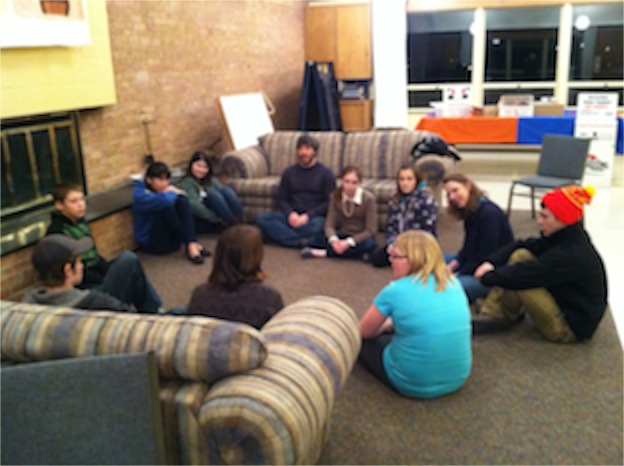
I confess that I don’t understand the practice of the Hindu faith. The closest thing we have to a ritual bath is the experience of baptism. I do not become excited by the feats of gods who are beyond the reach of humans. But it isn’t for me to judge the faithfulness of others. My calling is to practice the faith that I have been given among the people to whom I have been called. I have never felt that God calls me to be the leader of a huge crowd. We share the faith one-on-one. We experience the Spirit in small groups.
Jesus said, “For where two or three gather as my followers, I am there among them.” (Mt. 18:20) That is enough for me.
Copyright © 2013 by Ted Huffman. I wrote this. If you want to copy it, please ask for permission. There is a contact me button at the bottom of this page. If you want to share my blog a friend, please direct your friend to my web site.
Practicing Puncraft
Sign at the drug rehabilitation facility: keep off the grass.
Did you hear about the guy whose entire left side was cut off in a tragic accident? He’s all right now.
I forgot how to throw a boomerang, but then it came back to me.
Have you heard about the police officer’s three-year old son who was resisting a rest?
Sleeping comes so naturally to me that I could do it with my eyes closed.
I’ve always wanted to learn sign language. I figure it would be pretty handy.
Then, of course there are the long versions of puns. I’ve been known to tell a story that goes on and on in order to deliver a rather cheap pun as a punch line.
Puns are a particular form of humor giving the punster an opportunity to demonstrate their large vocabulary. Comedy writers as varied as William Shakespeare, Oscar Wilde and George Carlin have all employed puns. If you prefer, check out the Roman playwright Plautus. He wrote puns in Latin.
Some claim that the name “pun” is an acronym for “play upon names,” but I prefer the more technical and musical sounding appellation for the humor form: paronomasia. Wikipedia goes so far as to break down the humor form into classes and categories.
Homophonic puns use word pairs that sound alike but have different meanings. George Carlin’s famous line is an example: “Atheism is a non-prophet institution.”
Homographic puns use words that are spelled the same but have different meanings and sounds. Heteronymic puns take words in different parts of speech that sound alike and put them together in an unusual sentence construction. Doug Adams’ line, “You can tune a guitar, but you can’t tuna fish” is an example.
There are compound puns, recursive puns, and puns that defy classification.
Puns were the staple of vaudeville. “Why did the entomologist always look for examples shorter than six millimeters when studying Anthonomus grandis? He knew that you should always choose the lesser of two weevils.”
If you are groaning by now, you might want to just skip the rest of today’s blog. People who live with those of use who are incurable punsters learn not to react in the slightest to any of our silly jokes. My wife is a master of not reacting when I make pun after pun. Usually I stop after a while and she is able to return to intelligent conversation. Besides, she has already heard all of my puns – over and over again. So if you are a comedy writer or a comedian, you probably should stop reading at this point as well because few of my puns are original. They are often things that I have heard someone else say.
My cousin has started to make reversible jackets. I’m excited to see how they turn out.
Rule of grammar: double negatives are a no-no
John Deere stands behind every piece of machinery they ever sold, except for the manure spreaders.
Did you hear about the woman who got fired from the hot dog stand for putting her hair in a bun?
That was an emotional wedding. Even the cake was in tiers.
Oh, yes, I could go on and on. One pun begets another, which is why it is always a treat to get together with someone else addicted to puns. We try to deliver one liners in succession each seeking to outdo the other in the complexity of the set up before delivering the simple punch line.
The witches and wizards decided that it was time to embrace modern technology. They set about to create a giant database of all of their incantations. They consulted with their ancient books and they repeated the magical words over and over. The computer wizard did the entry, typing so fast that his fingers flew over the keys. Finally their system was complete. It was time to test the new online incantation database. They all stood back as the big black pot was warmed up next to the glowing computer screen. Each step of the process was repeated in the order displayed on the screen. Nothing happened. They tried again. Once again the incantation failed. It was only later that they realized that they had forgotten to use spell check.
It is better to have a short husband than none at tall.
It is better to have loved and lost than to have lost a towel.
Did you hear about the choir director who preferred former pirates? They were always willing to hit the high seas.
If you steal someone’s coffee, can you be arrested for mugging?
Oh yes, I have more of these than will fit into a 1,000 word essay. Actually, it is a pretty cheap way to complete this morning’s blog. Some days I just can’t come up with an idea for what to write about. I search through the headlines of the news and nothing strikes my fancy. I ponder what might interest my readers and come up blank. There are some days when I just can’t come up with anything for the blog at all. It is like my brain has gone on a topical vacation.
After months of accidents, mistakes, and problems producing the movie, the trailer was produced without at hitch!
The Bible is filled with puns. In the Song of Solomon we read of the man who in order to woo his sweetheart, “gave her wine and nectar.” Paul the Apostle wrote of his days of experimentation with drugs by saying, “I myself was once stoned.” Jesus actually employed real puns in his recorded words. He declared, “Upon this rock I will build my church.” If you have been following the text you know that the Ancient Greek word for rock was also Peter’s name, “petra.” Of course to really get all of Jesus’ puns, you have to have an understanding of Aramaic, the language he spoke. For example when Jesus called the Pharisees “blind guides, which strain at a gnat, and swallow a camel,” it looses a lot in translation if you don’t know that the Aramaic word for gnat is “gaima” and the word for camel is “gamia.” OK, so you had to be there to get it, but trust me it was hilarious when Jesus said it. What he meant is that Pharisees let punctilious piety blind them to mercy.
So I offer my apologies to those who have endured this entire blog. In my own defense, you should already know that I’m no Ernest Hemingway. Then again, the pun also rises.
Copyright © 2013 by Ted Huffman. I wrote this. If you want to copy it, please ask for permission. There is a contact me button at the bottom of this page. If you want to share my blog a friend, please direct your friend to my web site.
Responding to a Tragedy
Less understood is the dynamic of blame. When death comes suddenly or prematurely there is often an urge to fix blame as a part of the reaction of anger. Sometimes, such as in the case of a murder, there is a clear object of the blame. Often it is much more difficult to understand all of the dynamics that led up to the loss. Blame is often misdirected by grieving individuals and families.
It is not particularly surprising to me that the family of Internet activist Aaron Swartz issued a statement that criticized prosecutors for seeking “an exceptionally harsh array of charges (for) an alleged crime that had no victims.” They went on to claim that decisions made by prosecutors and officials of MIT “contributed to his death.”
I don’t blame them for being angry. Their burden of grief is overwhelming. Aaron was an exceptionally bright young man. Losing him at the young age of 26 must have come as a terrible blow for his family. He had shown such promise. He was technically brilliant, politically astute, and had a deep sense of justice. He was a crusader. He was a prodigy. His work on the social-news site Reddit and RSS, the technology that allows websites to send updates to subscribers were demonstrations of his brilliance. Some of us won’t achieve such significant breakthroughs in a lifetime.
Aaron Swartz was a bit of a folk hero among Internet activists. Anonymous, the loosely defined collective of so-called “hactivists” who oppose attempts to limit Internet freedoms responded to news of his death with a flurry of online activities. Anonymous claimed credit late Sunday for defacing several MIT websites. Tech, the campus newspaper, reported that users of MIT’s network lost access to most sites for nearly three hours Sunday night. Someone, claiming to represent Anonymous posted an online statement calling the government’s prosecution of Swartz “a grotesque miscarriage of justice.”
The charges faced by Swartz were serious. Prosecutors allege that he stole millions of online documents – mostly scholarly papers – from MIT through the university’s computer network. The federal charges that he faced could have resulted in decades of imprisonment if he were convicted. The seriousness of the alleged crimes depends, in part, on your point of view. Members of Anonymous saw it as a harmless stunt. Authorities at MIT saw it as a serious threat to academic security and freedom. Prosecutors saw it as theft of valuable assets.

Aaron Swartz died of a disease. It has a name: Depression. It can be treated. When left untreated it can have fatal results. And, as is the case in every suicide, the family and friends are left with an uninsurable question: “Why?” You can’t avoid asking the question. You might even come up with a partial answer. But the truth is that the reasons for Aaron’s actions were lost along with his brilliant mind at the point of his death. No one will every know for sure all of the details of the tragic events that accelerated into a tragic death.
I wasn’t involved. I never met Aaron. I never attended MIT. I don’t know the professors. I don’t know the prosecutors. I don’t know the technical details of the law. I don’t know how the computer network works or what danger the copying of documents might have posed. So it is easy for me to sit back from a distance and look at this death by suicide as I have looked at hundreds of such deaths over the years. It is a tragedy that might have been prevented. And it is an invitation for all of us to get involved where we can to prevent future deaths by suicide.
Life doesn’t have a rewind button. We don’t have the capacity to erase the tragic reality of the death of this brilliant young man. We can’t stop the family from experiencing pain.
We do know, however, that trained intervention works. Applied Suicide Intervention Skills Training (ASIST) is an internationally recognized standard for suicide prevention. ASIST-trained individuals prevent suicides every day. Over 80% of the persons who suffer from severe and chronic depression are effectively treated. We can only speculate what might have happened had Aaron’s attorneys, who were well aware of his depression, had been ASIST-trained. I’m pretty sure that everyone who worked with him now would agree that a two-day investment in training would have been worth it.
We expect all of our firefighters, police officers and ambulance workers to be trained in the lifesaving skill of CPR. We work hard to educate the general public about CPR. 911 dispatchers are trained to give instructions for CPR over the phone. How many lives could we save if we expanded ASIST training? How many tragedies could be prevented if it were as common as CPR?
None of my speculation is of any help to the grieving family. Perhaps expressing their anger in the form of blame will help them to deal with the weight of the tragedy. They will never get over their loss. With proper support they can survive.
Here is a number I share every opportunity I get: 1-800-273-TALK (1-800-273-8255). It is the National Suicide Prevention Lifeline. It is a source of support and help. Real live persons answer the phones 24 hours a day, seven days a week. You can always find help by calling that number.
The statistics teach us that everyone who was close to Aaron has an increased risk of dying by suicide. It isn’t too late to work to save lives.
Preventing death by suicide would be a fitting tribute and a meaningful memorial for Aaron Swartz. I hope we can find the resources as a nation for such a memorial.
Copyright © 2013 by Ted Huffman. I wrote this. If you want to copy it, please ask for permission. There is a contact me button at the bottom of this page. If you want to share my blog a friend, please direct your friend to my web site.
Gadgets I can live without
So I have no plans for a big celebration. However, just in case one of my family members is reading this, here are a few things that I would rather NOT receive as gifts in 2013.
The Stick N Find is a miniature tracking device that you can attach to whatever it is that you might want to find. It is about the size of a quarter, though a bit thicker and you can attach one to your TV remote control, another to your cat, another to your suitcase, another to any other device or item you think you might lose. The advertisement for the product suggest attaching one to your wife’s car, to your kid’s sneakers (assuming you want to track the kid wearing the sneakers, not find lost shoes), car keys, and the like. Then you install the application on your smart phone that allows you to set alarms when the devices are close or when the y go out of range. You can use the application to make the devices sound tones or emit light. Tracking devices are no longer the stuff of television spies and detectives. You can buy them and install them all around your home. However, I have no desire to own these devices. It isn’t that I don’t misplace things. I do that all the time. It is just that the way you find the misplaced items is to use your smartphone. The Stick N Find website doesn’t say what you should do when you misplace your smartphone. I know that is what I’d do and it would be difficult to explain to the person who gave you the Stick N Find. There are several companies working on similar devices including Tractive GPS pet trackers and GlobaTrac Tracdot luggage-tracking devices.
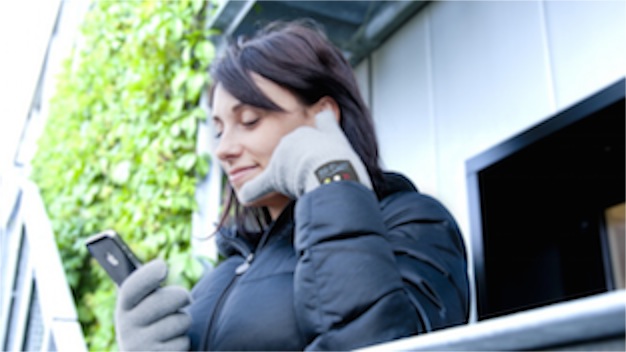

Just in case anyone is thinking of purchasing one as a gfit to me, and I don’t think anyone is, but just in case, I’ll take a pass on the YotaPhone. I haven’t seen the device, but it is described in the web site as a phone with two displays. One is the typical touchscreen found on many smartphones. The other is an e-ink display. You can load information onto the e-ink display and still be able to see it when the regular display goes into sleep mode. It can be frustrating to have some piece of information that you are ready to display only to have it disappear as you wait for the opportunity to show it. I’ve had this happen with electronic boarding passes and my Starbucks card. I have the proper item displayed, but then end up holding up the line while I get back the missing item after my phone display has gone into sleep mode. Let’s see, unlock the screen, touch the proper app button, etc. etc. Still, I don’t think I need a YotaPhone. First of all I would have to learn which screen is which. Then I’d have to learn how to get the information I wanted displayed onto the screen that doesn’t go to sleep. I’m thinking right now that one thing I don’t need in my life is a device with more things to remember about how it is operated. Perhaps the person who likes the gloves with the speaker and microphone would like one of these.

Now if I can just remember where I put my paddle last fall . . .
Copyright © 2013 by Ted Huffman. I wrote this. If you want to copy it, please ask for permission. There is a contact me button at the bottom of this page. If you want to share my blog a friend, please direct your friend to my web site.
The jargon we use
I have been hearing the term “evidence-based” frequently. Our state’s governor used the term frequently in his recent “State of the State” address. He was making the assumption that everyone knew what he meant when he used the term, but after listening, I’m not sure that the governor knew what he meant. The terms “evidence-based medicine,” “evidence-based practice,” and “evidence-based decision making,” all arose in the practice of medicine in the early 1990’s. They came from an attempt to bridge the gap between clinical practice and public health. The term originally was used in reference to the use of population health sciences to inform clinical practices. In this specific use, it did not mean the general application of scientific method to the practice of medicine – such practices were common prior to the use of the term. Rather it was the specific application of particular sociological studies to medical practice. The term caught on in the medical profession and soon there were multiple published studies of evidence-based practices applied to the practice of medicine.
I began hearing of the term outside of the field of medicine a dozen or so years ago. People would use the term “evidence-based” as a generic term for something that had a bit of scientific research behind it. In the church “evidence based” has been applied to everything from congregational growth to administrative practices. It generally is applied to an idea that has been tried and found to be successful in some other setting. I think that this is the way our governor was using the term in relationship to a package of judicial reforms. In that setting “evidence based” means that there is at least one other state that has tried a practice and that they found success in adopting the practice.
Taken to a logical extreme “evidence based” comes to mean the opposite of innovation. “Evidence-based” comes to mean that the idea didn’t originate with us. We saw (or heard of) someone else doing a particular thing and we have decided to imitate it. Imitation isn’t necessarily a bad thing in government or in the church, but it does tend to limit creativity and the adoption of new ideas. In political debate the use of the term in this manner leads to a logical fallacy. An idea is not inherently superior simply because it is not original. To return to the example of the governor’s speech, one part of the proposal, the expansion of drug courts, is something in which South Dakota trails the nation. All other 49 states adopted this practice prior to its use in South Dakota. It is a good idea, and one that is successful. But it was just as good an idea for the first state that adopted it and has been far more successful in places where the practice has been in place for decades. It doesn’t mean we shouldn’t do it but if “evidence based” means waiting to see how it works in some other place before we try it ourselves, we are destined to always be imitators.
Another term that has evolved from the same origins that is extremely popular in the church these days is “best practices.” Essentially it has come to mean the same thing. “Best practices” are things that have been successful in other settings. Like “evidence-based” the over use of the term “best practices” has come to stifle creativity and innovation. Ideas have to run their course before they are identified as “best practices.” This means that those who seek to always be involved in “best practices” are always imitating what has already been done somewhere else. Often their timing is off simply because they have delayed their action to see what the results of action will be in another setting. In the church “best practices” is often an excuse for a failure of leadership. It becomes a “let’s wait an see how it goes for someone else” attitude.
Another problem with the term “best practices” as it is used in the church is that it often doesn’t take into account the wide variations in settings in which the church does its work. A “best practice” in Boston, might not be the best idea for a congregation in Buffalo, South Dakota. The dynamics that produce success may have much more to do with the sociology of the setting than the program or activity that is put into place. I don’t know how many times in my career I have seen a pastor or lay leader be impressed with something that is being done in another congregation and fail when attempting to imitate the same program in their own congregation. We are not all the same and what works in one setting may or may not work in another setting.
Best practice is a buzzword that the church adopted from business management. There are accredited business management standards such as ISO 9000 and ISO 14001 with have specific practices that, theoretically, can be applied in a variety of different settings. In practice, however, chasing the standards often results in business failure. “Best practices,” are often suggestions from consultants that are brought in after multiple problems in an organization and frequently do not provide positive results in a field where innovation is a key to success. Successful businesses and successful congregations tend not to be slaves to the whims of fashion. Focusing attention on what others are doing is rarely the pathway to growth.
We will continue to use jargon in the church and in our wider lives. There are some days, however, when I cringe at one more person using terms like “best practices” or “evidence based” when it is clear that what is needed is less talk and more action.
Copyright © 2013 by Ted Huffman. I wrote this. If you want to copy it, please ask for permission. There is a contact me button at the bottom of this page. If you want to share my blog a friend, please direct your friend to my web site.
Snow day
When our kids were in school, we loved snow days. They were a break from the routine for the whole family. But I also have great sympathy for those who have to make the decisions about canceling school. I really don’t like it when the job falls to me to make a decision about cancelling or postponing a church meeting when the weather turns harsh. We have cancelled worship twice since I have been serving this congregation. Both times, the city police were advising no travel within the city. Both times I ended up driving into the church to make sure that the building was all right during the storm.
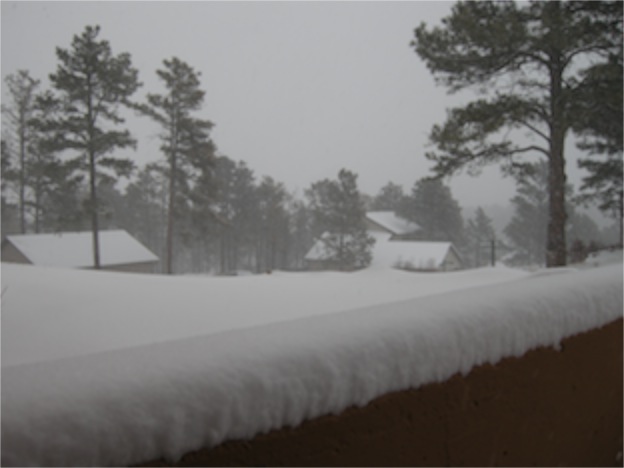
The snowfall was lovely. It was relatively cold and the snow was light and powdery. We got about four inches at home and I heard that the wind was gusting out on the prairies. The Highway Patrol has issued a no travel advisory for the Interstate starting at Rapid City and extending for 70 miles.
We had a lovely supper and turned on the porch light to see if the snow was still falling. It was a good day for making a few home repairs, for reading and for a bit of work on the computer.
Some of my neighbors were having a bit of trouble with the snowy roads. There were a few who shoveled their driveways, but I decided to leave that task until this morning. On neighbor up the hill gave up trying to get his car into his driveway. He left it parked on the street, which we try very hard to avoid because it makes it difficult for the snowplow. He can be forgiven. This is his first winter here since moving from Austin Texas. It takes a bit of nerve to keep your speed up as you head up the hill and turn into your driveway. After a few years, the maneuver becomes second nature. I remember giving our kids a bit of help when they were learning to drive. Tex is either gonna get used to living here or someday he’ll head back to a place where it is warmer in the winter.
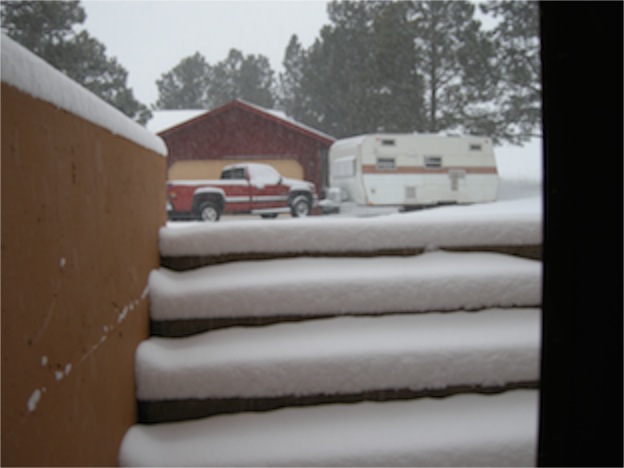
I am, however, still a pastor, so, as has happened before, the phone rang just after I had dozed off and I got up, got dressed, put on my parka and hopped into the pickup truck to go be with a family with a member in the hospital as they struggled with some difficult medical decisions. The crisis passed, at least temporarily, and I was back in my bed a little after 2 a.m. The roads hadn’t been bad at all. All of the major roads had been plowed and the street in front of our house wasn’t difficult to navigate in four-wheel drive.
The packed snow tracks from driving in and out of the driveway won’t be a problem when, a little later this morning, I tackle the job of getting the driveway cleared out. That is one thing about cold weather, the snow comes off of the driveway easily. And this snow is pretty light. But I will want to check things out at the hospital this morning and as long as I’m heading into town, I’ll swing by the church and make sure that everything is OK.
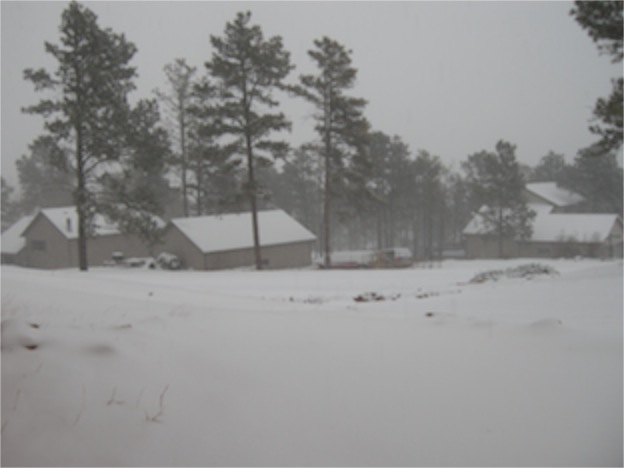
That’s the way we get snowed in. We can really get out when we need to. It wasn’t that way for the folks wintering above the Arctic Circle in 1924. The book I’m reading tells of winter that makes our conditions seem positively balmy by comparison.
Copyright © 2013 by Ted Huffman. I wrote this. If you want to copy it, please ask for permission. There is a contact me button at the bottom of this page. If you want to share my blog a friend, please direct your friend to my web site.
Wild animals!

We know the bucks get crazy at this time of the year. We’ve watched them ignoring cars on the road, people in the yard, and lots of other potential distractions in their quest to find mates. And we know of stories of others who have had deer inside buildings. The stories usually involve large windows. Patio doors seem to get broken as well. The general theory around here is that the buck sees its reflection in the glass and then lunges at it as if it were a rival. I also read of an 83-year-old woman in Pittsburgh who had a deer break through her window. The woman triggered her lifeline and help soon arrived to usher the deer out the front door. There was a bit of a mess to clean up.
There is no indication that the deer was any more educated as a result of its trip to school, however.
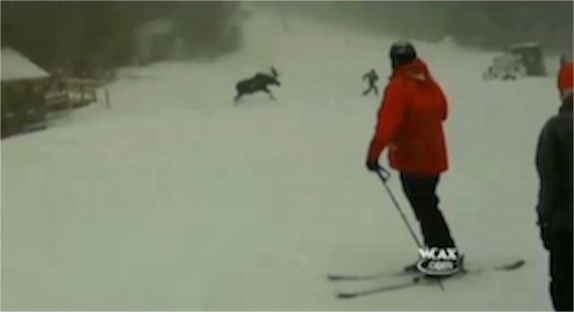
There are so many video cameras around ski resorts these days that it probably isn’t surprising that someone caught the scene on video. The Internet means that a lot of us who are far away from Vermont got to see the video within a few days of the incident. Actually, it doesn’t look all that scary. I think Palmer might have done just as well to ski away down the hill. It won’t keep me from going skiing. Actually, I like to see moose. I don’t get the opportunity too often. The one time we did have a moose step on to the road in front of our car when driving in Canada, it did startle us and get our attention right away. Even from the seat of the pickup – those are very large animals.

Back here at home, I’m sort of wishing for a day that is more calm when the deer remain outside, no moose take to chasing me and I spot no lions running lose on the streets. A little snow will be welcome as we crawl into bed this evening and I hope I wake to a good old-fashioned (thought short-lived) Dakota winter blizzard. We’ve got plenty of food in the pantry, extra firewood stacked near the back door, good books to read and the promise of a day off tomorrow as we prepare for worship on Sunday. Life is good and we could use the precipitation. The weather service has downgraded their predictions about the amount of snow, so we probably won’t get buried, but a few inches of new snow will cover up the unfinished yard work and make the world beautiful when viewed from inside our warm home. We are expecting that we won’t need to travel and if we do need to make a run to town to visit someone, we have reliable vehicles.
So stay indoors, keep warm, and watch out for dangerous animals. I think you can easily have a safe weekend.
Copyright © 2013 by Ted Huffman. I wrote this. If you want to copy it, please ask for permission. There is a contact me button at the bottom of this page. If you want to share my blog a friend, please direct your friend to my web site.
Snow
But they’re experiencing winter this week as storms sweep across the Middle East.
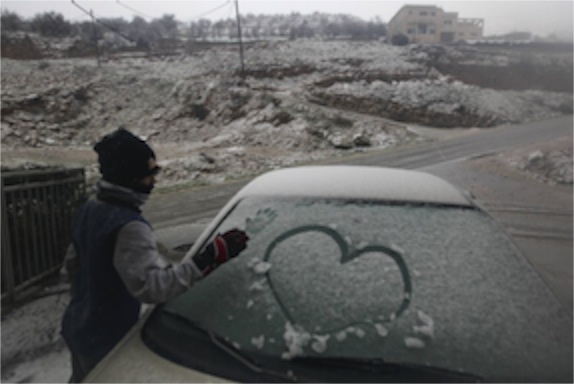
It is winter in the Middle East. Forecasters have warned that the worst is yet to come. It is a couple of weeks late, but it seems that it does sometimes snow in that part of the world.
Meanwhile, forecasters have issued a winter storm watch for our part of the world for tonight through tomorrow. They rarely predict 100% chance of precipitation, but that’s what the forecast is showing right now. We might get as much as six inches by Saturday morning. That really isn’t too much snow for us. We like the snow and it is good for the health of the forest. Our ground is dry and the moisture will be much appreciated. It would be a concern if we had to travel across the state, but such a storm is unlikely to cause much of a disruption for us. We’ll get out our parkas and, who knows, I may even fire up my snow blower before the storm is over. I have a nice machine, but it doesn’t get much exercise some winters. It isn’t worth getting it out for a dusting. I can run the shovel across the driveway, but it is nice to have when the snow gets heavy.
But we are used to snow. We look forward to snow. With recent winters being light on the snow, we even hope that we will get more snow.
And our part of the country is set up for snow. The county and city have large trucks with big plows and machines for spreading sand and salt on slippery highways. We have efficient heating systems and lots of insulation in our homes. Our windows seal out the drafts and are designed for winter weather. About the only preparations that remain for us is to check the pantry to make sure that we have plenty of groceries for a few days and make sure the gas tanks of the vehicles are full so we don’t need to go to the stores if conditions get slippery. Getting snowed in for us is always a fun adventure that doesn’t last very long. And, in the case of an emergency, we have a reliable four-wheel drive. If I put chains on all four tires, we can make it to wherever we need to go in weather that is more severe than what we have in the forecast.
It is different in the Middle East. There are hundreds of thousands of refugees living in camps where the roof may be a light tent reinforced with a blue plastic tarp. A dirt floor may not be much of an inconvenience in dry weather. An old carpet can be spread and the place made livable. Conditions are vastly different when the dirt turns to mud. Keeping the water out of the tent can be a challenge when one lacks tools.
Conditions in the Middle East are record setting. It is the most severe storm to hit the region in a decade and the wettest in at least 20 years. Freezing and flooding are not a pleasant combination. Floodwaters are rising and there have been reports of winds gusting as high as 70 mph along the eastern Mediterranean coast. Most refugees do not have any source of heat in their tents. A few wood stoves exist within the camps, but firewood is scarce and fuel to heat is difficult to obtain.
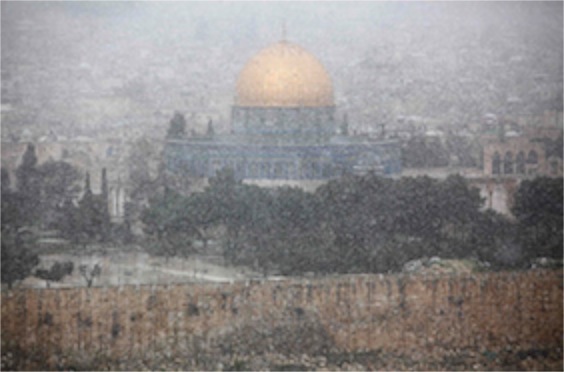
So, for now, I prefer to think of the birth of the Christ child occurring on a night when it didn’t snow and there weren’t storms. The child was born into poverty and his parents soon became refugees as they fled their country to save the life of their child in the face of the rage of Herod. Had it been stormy, the Holy Family would have been in the midst of the suffering.
Christ is still present with those who suffer.
Copyright © 2013 by Ted Huffman. I wrote this. If you want to copy it, please ask for permission. There is a contact me button at the bottom of this page. If you want to share my blog a friend, please direct your friend to my web site.
Many ways to grieve
As a pastor, however, I have learned that there are many other traditions and that those traditions are deeply meaningful to others. I think I am a bit less awkward these days when someone offers me a hug. I have learned to respond in kind. And I no longer get embarrassed when someone cries in my presence. After all, my job is ministry to the whole person and a whole person comes with emotions. God accepts all of the feelings of the people and a minister should be open to them as well.
Along the road, I have learned that there are many different ways of expressing grief. And there are many different traditions surrounding funerals. In my family, we don’t linger with the body once a person has died. We make quick arrangements to have the body dealt with in a loving manner and then we gather at the church for a memorial service. Then we go home and grieve privately. We focus on the presence of the spirit of our loved one, on the love and the gifts that we have shared. We don’t go in for public viewings and other displays of our grief.
But our way isn’t the only way. In fact it might not be the best way.
The rituals of mourning vary by culture and tradition. There are specific rules governing the practices of mourning in some cultural traditions. The Jewish practice of shiva is a specific ritual of mourning for the seven days following the death of a loved one. There are rules about how the days are counted, the effect of Sabbath on the mourning process, what happens when there is a high holy day (Rosh Hashanah, Yom Kippur, Sukkot, Passover and Shavuot) during the shiva. Neighbors and friends provide meals. Mourners do not bathe or shower, they do not wear leather shoes or jewelry, men do not shave and mirrors are covered. Practices have evolved over time and are observed with different details and in different ways depending on the specific traditions of a particular family or situation.
The English tradition of wake has evolved into different forms in different places. We often associate the practice of observing a wake with the Irish, but the word comes from an English practice. The Irish “faire” is a similar ceremony. A traditional wake takes place in the home of the deceased with the body present. These days wakes are often held in public places rather than the home. The tradition comes from the practice of staying alert and guarding the body from the time of death until the time of burial.
In our corner of the world, we observe wakes most often with our Lakota and Dakota sisters and brothers. The tradition of a wake before a funeral is strong and long-standing in native communities. A wake is usually held in a public hall such as a church fellowship hall or a community center. The body is prepared by a funeral home and the casket is brought, with ceremony, to the hall where there are lots of quilts and pictures and other memorabilia displayed. The wake involves formal prayers, but also lots of time for telling stories of the person who has died. Food is served and shared among the mourners. The wake begins the evening before the funeral and continues throughout the night until the time of the funeral.
Even though it is not a part of my tradition, there is something very natural about a wake. It is natural to want to stay with the body of a loved one until it is buried or cremation takes place. Sleep patterns are disrupted for those who mourn. Tiredness and exhaustion are part of the grieving process. And telling stories and sharing meals are part of processing grief. It takes time to adjust to the new reality of life without the loved one and some formal rituals assist with that dramatic transition.
It is an honor to be invited into the grief of another – to share the journey with a friend.
Our church has been honored by a family who are currently holding a wake in our building. I’ll be going to join them shortly after having sat with them into the evening last night. The funeral will be at 10 this morning with military honors and burial at Black Hills National Cemetery to follow. We are already short of sleep and a bit tired from all of the activities of preparing for and participating with the family in the ceremonies that have already taken place. We will be nearing exhaustion by the time it is over. Then we will pick up the pieces and go on with the life of a busy and active congregation.
One of the gifts of grief is that it disrupts our routines. Our schedules are interrupted. We don’t carry on in the usual way. We are given the opportunity to look again at what is most important. And we discover that the things we often think are important aren’t really that important after all. Deadlines can be adjusted. Routines can be changed. Schedules can be altered. And that isn’t a bad thing.
The truth of this life is that we are not in control. Any illusion of control is temporary and clouds us from the larger reality that we belong to each other and we belong to God. So we remember and we follow the traditions of our people and learn some new traditions along the way. And God’s gift of grief begins its work in our lives. And if we learn that we are not in control, it is a lesson that will serve us well in the years to come as we practice our faith in the midst of the realities of life.
Copyright © 2013 by Ted Huffman. I wrote this. If you want to copy it, please ask for permission. There is a contact me button at the bottom of this page. If you want to share my blog a friend, please direct your friend to my web site.
Living in a Spiritual World
People like Richard Dawkins, Sam Harris (who charges $50k for a speech and travels with his won security detail), Christopher Hitchens, Daniel Dennett, and Steven Hawking all have made significant money and forged careers that are in part based on attacking the beliefs of others. The appear to be investing significant energy in an effort to persuade others to abandon belief in God and embrace their beliefs. They claim to be without belief, that all of their assumptions are based on pure, unbiased logic, but that seems to not be the case to me. I’m no expert on atheism. I’ve read a few of the books by these people and I’ve listened to interviews with them an a few public debates, but after a while their arguments tend to bore me.
The arguments that people should not believe in God seem to fall into two general categories: There are arguments based on the fact that much evil has been done in the name of religion and therefore religion must be harmful. Part of the argument is based on historical fact. People have done awful things in the name of religion. The attempt to convert others has frequently led to unspeakable violence. The church has been complicit in human tragedy on many notable occasions. But these speakers then turn to science. As if science hasn’t been at the heart of much evil. As if science had no role in the death of innocents. As if the outcomes of science were somehow more humane, or more positive than the outcomes of religion. That is a case that is hard to make and appears silly to an outsider.
The second category of argument against religion is based in a notion that all religion is founded upon a belief in a supernatural being. These contemporary atheists sound more like pantheists than atheists to me. They tout a belief that the universe is the total of what has existence. They seem to speak of the vastness of the universe and its all-encompassing nature as the sum total of what exists. This is not a new belief, although the size of the universe is a modern discovery. There have been people around for millennia who believed that the sum total of all of the world (or of all of the universe) is the same as God.
As I said in the beginning of this essay, I have no particular need to argue with these people. I don’t feel compelled to change the way they see the world or what they believe. But it seems to me silly to think of them as people who have no beliefs. It seems ridiculous to think of them as somehow more rational or logical or free from assumptions than others.
Were I to have a conversation with them, I suspect that I would try to say to them that, in many cases, the god in which they do not believe is a god in which I also no not believe.
My faith, Christianity, is focused not on the supernatural, but rather the presence of God in the midst of the world. We see the divine in human form. We experience the spirit not as something from out of this world, but rather as something intimately present in every aspect of the known world. When an atheist says that we can’t prove that there is something beyond the known universe, I simply sigh and think you don’t have to look beyond the universe to recognize what is present in this world. I suspect that a debate between a leading atheist and me would become as boring as the writings of those atheists are for me to read.
Here is what I know: God is spirit and we are, at our core, spiritual beings. My observation comes from an experience that humans have been having from the earliest of times. I have been present a times of birth and of death. The language of science is helpful in understanding what we have observed in such moments, but it is far from a complete description of the reality. The language of faith may also fall short of being a complete description, but it is no less adequate than the language of science at such moments. I know, I have seen hard-core scientists at a loss for words. I have watched them squirm and struggle to find the words to speak in moments when I suspect the better thing would be to be silent.
I am no expert on Native American religions, but I do know that many Dakota and Lakota people have a strong belief that we are spiritual beings who have temporarily taken on physical form. From spirit we have come, to spirit we will return. Their perspective, it seems to me, is as plausible as that of scientists who believe that the only realities are those which can be directly observed or inferred by a particular application of human logic. To say that the only things that are real are the things that I think (or say) are real is a very self-centered notion.
Superscholar.org has created a list of the 25 most influential living atheists. It is not a multi-cultural crowd. It is mostly European and American white males. Only three women made the list and they are all successful scholars working in traditional academic settings. To assume that they operate without cultural biases is as silly as another assumption they wish we would embrace: that the smartest people are all university professors.
This afternoon I will begin an ancient tradition of observing an all-night wake with a traditional Lakota family. It is not a practice I would recommend for those who want to remain atheists. I have no doubt that the spirit will be present – in the midst of the realities of this world. I have no doubt that death is not the end. I have no doubt that love never dies.
Those who do have doubts are welcome to join us.
Copyright © 2013 by Ted Huffman. I wrote this. If you want to copy it, please ask for permission. There is a contact me button at the bottom of this page. If you want to share my blog a friend, please direct your friend to my web site.
Australia Burning
Today’s forecast calls for slightly cooler temperatures, but still pretty nice. It is about 30 degrees out there right now and we should see a high in the upper forties. Still, it is winter in the plains and we have more storms and snow ahead before springtime comes. This break will allow us to wash our cars and catch up a bit, but it is too early to think about yard work around here.
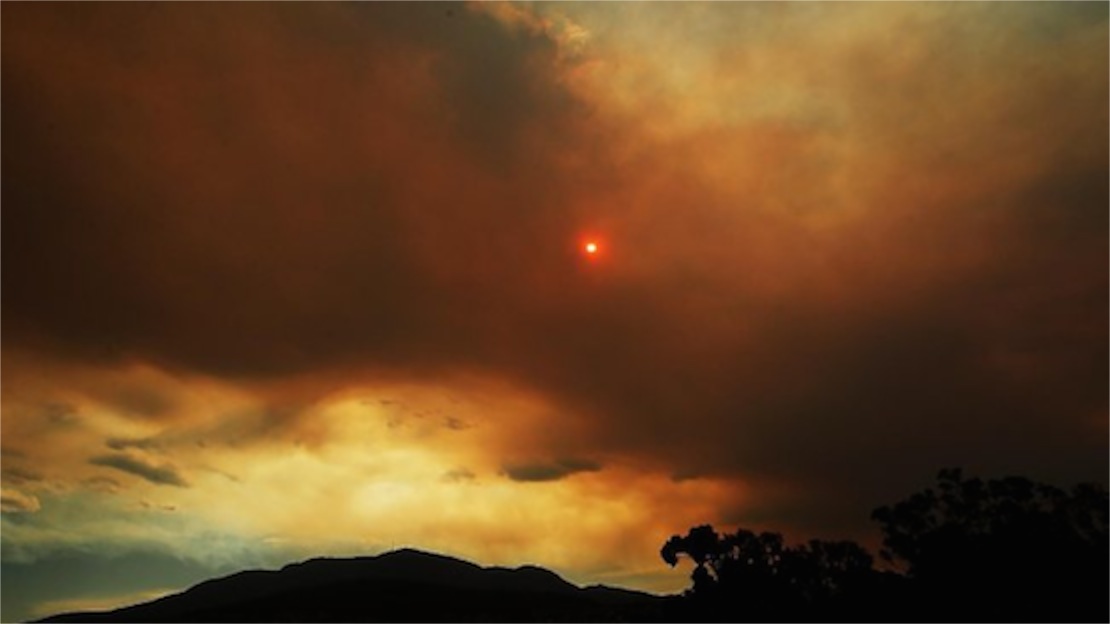
What I am thinking about is the weather in Australia. They have been having temperatures in the forties, too. But they use the Celsius scale. The temperature in Hobart, in Tasmania, was a record-setting 41.8 on Saturday – that’s 107 degrees on the Fahrenheit scale. Tasmania is often cooler than the rest of the country. Located off of the southern coast, with nothing but ocean separating it from Antarctica, it can be a chilly place, but that hasn’t been the case this summer. Summer isn’t halfway over in Australia and already there are new records for temperatures, and for fires.
Firefighters are battling hundreds of blazes all across southern Australia and officials are warning of catastrophic conditions with high winds and more temperatures staying above 100 degrees (F) throughout the week. Authorities have warned all people staying in campgrounds to evacuate, regardless of their proximity to current fires. Lighting and arsonists can turn almost any place in the bush into a nightmare in a matter of minutes. Everyone in Australia is urged to have a bushfire plan and to be ready to leave home when notified. Australians know from experience that city neighborhoods are not immune from devastating fires.
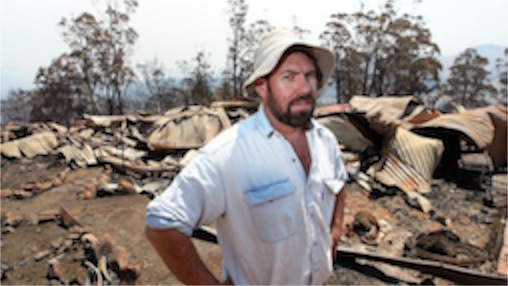
It is holiday season in Australia. Summer vacations are in full swing, and Tasmania is a great vacation destination – when it isn’t on fire. Among the stranded people are tourists. Boats have ben used to evacuate some people and other boats are being used to shuttle emergency supplies to remote and isolated areas on the peninsula.
The locals call it the “Tazzie Spirit.” It is a way of life that includes helping neighbors and working together. The friendliness of the people is an important part of the attraction of a visit to Tasmania, and it is a quality that is essential to survival now that the island state is so deeply threatened by fire.
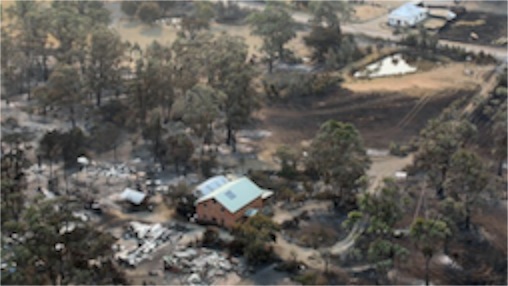
Half a world away, I stare at the computer well aware that there is little I can do but pray. The work of rescue and recovery will fall to others. We can participate through disaster funds made available through church partnerships, but the real work will fall to those who live there. The “Tazzie Spirit” will need to affect Victoria, New South Wales, South Australia and Queensland as well. The fire season is far from over down under.
The forecast is for temperatures to top 110 degrees Fahrenheit in Sydney Tuesday. It is going to be a long, hot summer in Australia this year.
The debate about whether or not we are experiencing global climate change is over. The vast majority of scientists agree that changes are occurring and that the rate of change is higher than previously predicted. Climate changes are already having an effect on food and crop production and there are more devastating changes yet to come. When we visited Australia in 2006, many of the people we met there were surprised that there was even a debate about climate change in the United States. They had experienced enough changes to be convinced. The climate change doesn’t manifest itself in day-to-day temperature records, but it is becoming clear that there will have to be major changes for people in the new climate realities of our planet. Some of those changes are not going to be easy as is evidenced by the amount of resistance and political maneuvering to protect the status quo in terms of energy consumption, fuel sources and other human activities that have an impact on climate.
In the midst of all of this, perhaps we all would benefit from a dose of “Tazzie Spirit.” We’re going to need to be good at helping one another in the midst of crisis. There are more disasters on their way.
Copyright © 2013 by Ted Huffman. I wrote this. If you want to copy it, please ask for permission. There is a contact me button at the bottom of this page. If you want to share my blog a friend, please direct your friend to my web site.
Myrrh

Epiphany always brings to mind what seems to me to be the most common hymn about the three kings:
We three kings of orient are
Bearing gifts we traverse afar.
Field and fountain, moor and mountain,
Following yonder star.
O star of wonder, star of night,
Star with royal beauty bright,
Westward leading, still proceeding,
Guide us to thy perfect light.
It is one of the hymns of which I have memorized the words to all of the verses. We sang it at Christmas every year. Many years there were three boys, each singing solos for verses two, three and four – the verses of the individual kings’ gifts: gold, frankincense, and myrrh.
The “gold” is easy:
Born a king on Bethlehem’s plain,
Gold I bring to crown Him again,
King forever, ceasing never
Over us all to reign.
And “frankincense” is pretty easy, too:
Frankincense to offer have I.
Incense owns a Deity nigh.
Prayer and praising all men raising,
Worship Him, God on high.
But the “myrrh” verse is relatively hard to memorize:
Myrrh is mine: it’s bitter perfume
Breathes a life of gathering gloom.
Sorrowing, sighing, bleeding, dying,
Sealed in a stone-cold tomb.
So what is it with the gifts, anyway?
The gold makes sense. The parents were impoverished. A bit of cash can always help with the expenses of a new baby. There are all sorts of unforeseen expenses associated with a new child. On suspects, from reading the whole story, that it wasn’t enough gold to make anybody rich – maybe it was enough to help with the expenses of a flight to Egypt to save the life of the child. These days when a family has to make a big trip to save their child’s life, the resources of the wider community come into play. We raise money to support refugee camps and to help with those who have to travel long distances seeking medical care. The gold was a practical gift.
Frankincense is a symbolic gift – one that sort of makes sense if you think about it. The incense had uses in the practices of the temple. It was, in a sense, a gift suitable for a priest or religious leader. Jesus, it turned out, didn’t become a temple official. He was a new kind of religious leader, but as a baby, people couldn’t have known his future. The gift of frankincense was an acknowledgement that this baby had special religious significance. Why, out of all of the accouterments of the temple frankincense was chosen, is a bit of a mystery. The temple in those days was a place of animal sacrifice, with all of the smells associated with such activities. The incense was one way to combat some of the negative odors associated with the practices. They burned a lot of incense to cover up some rather strong odors.
Babies can get stinky, too, though incense usually isn’t the best way to deal with the odors. A good diaper pail might have been a more practical gift.
The mystery gift, however, is the myrrh. One normally does not bring embalming fluid to a birthday party. OK, myrrh isn’t exactly embalming fluid. It is, however a resin that was valued because of its odor and its ability to mask other odors. It was commonly used in the preparation of bodies for burial. In the warm temperatures of the Middle East in the days before embalming, a body began the natural process of decaying. Burial was usually completed quickly. The practice of using caves as tombs was a way to get the body into the ground quickly without the chord of digging in dry ground on a very hot day. The odor was strong enough that it is mentioned in the Biblical story of Lazarus. Martha warns Jesus of the odor when he asks them to take the stone away from Lazarus’ tomb. (John 11:39)
So they used myrrh to help control the odors when someone died.
But it is a really strange baby gift.
The gift, however, goes beyond some sort of morbid foretelling of Jesus death. We will get to the stories of his death quickly enough. Christians don’t avoid the tales of that time, but the story of the visit of the Magi in Matthew’s Gospel is a story of escaping the infanticide ordered by Herod. Jesus escapes death in that particular story.
The gift of myrrh is an acknowledgment that sorrow and grief are a part of every human life. Jesus would grow into a man who witnessed too much death, who saw too much sorrow, who experienced too many tears. In the story of Lazarus’s death we find the words of what we believed to be the shortest memory verse in the Bible when we were children: John 11:35: “Jesus wept.” Jesus himself knew grief.
But we rarely understand that our grief is a gift of God. We aren’t quick to recognize grieving as a gift. It is painful to grieve. It doesn’t feel good or normal or ordinary. Sometimes, in the midst of grief, we feel as if we are losing our minds. We don’t like the sensation at all.
Grief, however, is a sign of how much we care. Grief is a reminder of the love we have shared. Grief is part of life in community. Love and care and community are gifts of God. As I work with people, I have discovered that grief is in fact a good process. Loss is inevitable. How we respond to loss is what makes the difference. Allowing ourselves to grieve is a way of responding to the loss that keeps us close to the core values of love and care and community.

Still, it is easy to imagine Joseph turning to Mary as the magi departed and saying, “The gold is nice and I suppose we’ll find some use for the frankincense, but what are we going to do with the myrrh?”
Copyright © 2013 by Ted Huffman. I wrote this. If you want to copy it, please ask for permission. There is a contact me button at the bottom of this page. If you want to share my blog a friend, please direct your friend to my web site.
Witness to a miracle
I know I was praying for things to take a different turn than they did last night. The story is at the same time familiar and fresh. I received a call on my cell phone that a church member was being rushed by ambulance to the hospital. I was about ten miles from the hospital and the family had been there for a few minutes by the time I arrived. They were gathered in the small waiting area between the emergency room and a hallway. I’ve been in that room a hundred times before. I have had the job to carrying news of the death of a loved one to families waiting in that room. I have tried to console grieving people in the midst of a windowless area that is too small, crammed with institutional furniture and lacking some of the essentials one needs for such a task. When I am working with the LOSS team, I carry packets of Kleenex in my briefcase so I don’t have to wander out to the nurse’s station to find tissues. I know how to get glasses of water and other simple amenities for those who wait in that place.
But this time I was in the role of pastor. I didn’t have my briefcase. And I didn’t have the news. We waited together. It didn’t take long, but the big clock in that room moves so slowly that a few minutes seems like an eternity. There was time to hear the roughest outline of the story and to share a brief prayer with the family.
There wasn’t much story to tell. They were going into the house after an outing that included lunch and a stop at the pharmacy to pick up some prescriptions. He started up the few steps that lead to the kitchen and hesitated. She saw his hand slipping on the railing. She tried to hold him upright, but he is a big man. When he slumped, she was underneath him. She scrambled out, called 911 and tried to move him to a more comfortable position. The police and fire department and paramedics came and started CPR. There was a flurry of activity as they loaded him into the ambulance. She rode to the hospital in the back seat of the police cruiser. They were giving him medicine. We were waiting.
We didn’t have to wait for the doctor to say any words when he arrived. The doctor and nurse came into the room and I already knew what they were going to say. You could tell by the tired expressions on their faces. You could see it in the way they strained to look people in the face. Since I’ve had the job they had on previous occasions, I know a bit of what it feels like. But the doctor did find a few comforting words. He did describe what they had done in an all-out effort to save a life. I think he used the words, “There was nothing to do but to let him go.”
It was a blur of tears and a gush of emotions. I explained what would happen next and asked the widow – she is a widow now – when she would like to see him. As is usually the case, she wanted to see him immediately. I persuaded her to wait a few minutes for them to organize a few things in the room before we went in together.
We had been praying for a miracle. We wanted him to survive one more life-threatening experience. We had witnessed his courage in the face of other dangerous situations. We had known that he was a survivor. We wanted a few more years and if we couldn’t have that then at least a few more days. We would have settled for a few more hours. That was the miracle we wanted.
The miracle was no less a miracle just because it wasn’t what we wanted.
We were given the miracle of family love. We were given the miracle of friendships that are strong and resilient. We were given the miracle of caring and competent police, firefighters, paramedics and emergency room staff. We were given the miracle of community. We were given the miracle of a church that supports people in good times and in bad. We were given the miracle of Christ’s presence in the midst of grief.
And once again I witnessed something that I know is true, but that we often overlook. We human beings are amazingly good at grief. I don’t mean this to sound trite. It isn’t. But when circumstances are such that you might expect a person to fall apart, that person doesn’t fall apart. When the pain and grief are so deep and real that you would think a person would just come unglued, they don’t. Instead, we shed a few tears, experience a burst of confused emotions and get about the work of adjusting to an entirely new way of life. Before long grieving persons are making decisions, calling family and friends, telling the stories, and remembering the good times as well as the trauma.
Despite what you might think, we are really pretty good at the tough and awe-filled task of grief. Despite what you might think, God is no less present in the dark moments of our lives. Despite what you might think miracles occur even when we don’t get what we want. Sometimes it takes us a little while to recognize the miracles we are given.
Of this much I am certain: Love never dies. And God is love.
Copyright © 2013 by Ted Huffman. I wrote this. If you want to copy it, please ask for permission. There is a contact me button at the bottom of this page. If you want to share my blog a friend, please direct your friend to my web site.
Thirteen
I’ve stayed in hotels that don’t label the 13th floor, or at least that call it the 14th floor. The elevator as a 12 and a 14 button but no 13 button. I guess they have trouble renting rooms with the number 13. Of course, I have always wondered how many people that actually fools. If one were really suffering from triskaidekaphobia, wouldn’t it pay to avoid the 14th floor in hotels as well, just because of the way that they number them?
But it is a bit hard to avoid the whole year 2013. I wasn’t around in 1913, so I don’t know much about how people approached that year. Woodrow Wilson was sworn in as President of the United States. Henry Ford finally got his moving assembly line going, reducing the assembly time for one of his cars from 12½ hours to 2 hours 40 minutes. Down under, in Australia, they started building the then new capital, Canberra. John D. Rockefeller established the Rockefeller foundation with a donation of $100,000,000 – big money in those days. Stravinsky premiered the ballet, “The Rite of Spring,” causing a riot. And Pancho Villa was battling it out with the authorities in the Mexican Revolution. In Bavaria, Otto Wilhelm Luitpoid Adalbaert Waldemar von Wittelsbach (King Otto) was succeeded by King Ludwig II. Otto had been suffering from mental illness for a long time and had been confined to Furstenried Palace near Munich for years. All in all, it was a year of good luck for some and not so good luck for others. I suspect that 2013 might prove to be a mixture of good and bad as well.
I’m not much for superstitions. I remember that the number 13 is supposed to be unlucky because that is the number of people at Jesus’ last supper: Jesus and the 12 disciples. At least that is how many people are shown in the famous painting. But it is possible that there were others present. I properly tied noose is supposed to have 13 turns, but I don’t know if that is because the number 13 was already considered to be unlucky or not. They say that it is unlucky to have 13 guests at a dinner table. Our table isn’t big enough for 13 anyway. We’d have to set up a card table for the extras.
But as we adjust to writing the new date, it is worth noting that the 21st century is getting a few years on it. It doesn’t seem so long that the year 2000 was a kind of new adventure. We awaited the dawn of the new century with a bit of fear as Unix coders scrambled to correct some dating problems in obscure lines of computer code. The fix seemed to work and the power grid continued to work. The disruption of the so-called millennia problem was no greater than the end of the 13th Baktun in the Mayan calendar. Dates seem to come and go and already we’re into the second decade of the new century.
I’m not good at predictions, but it seems likely that this year will bring the deaths of some beloved elders and probably some tragic losses that catch us by surprise as well. There will be a mixture of grief and celebration, good news and bad news, joy and sorrow. That is typical of each year.
But I’m not ready to join the writer of Ecclesiastes in declaring that there is nothing new under the sun. The circular view of time presented in that book seems to be a sort of Biblical minority report. Much of the rest of the Bible presents history as proceeding from a beginning and heading towards fulfillment of the promises of God. Then, in the midst of it all, there is the opening of Ecclesiastes with its sense that “what comes around goes around.” It does seem to be a perspective that stands in contrast to much of the rest of the bible.
Shakespeare questioned the idea in Sonnet 59:
If there be nothing new, but that which is
Hath been before, how are our brains beguiled,
Which, labouring for invention, bear amiss
The second burden of a former chil.
O, that record could with a backward look,
Even of five hundred courses of the sun,
Show me your image in some antique book,
Since mind at first in character was done!
That I might see what the old world could say
To this composed wonder of your frame;
Whether we are mended, or whe'er better they,
Or whether revolution be the same.
O, sure I am, the wits of former days
To subjects worse have given admiring praise.
I don’t know if your time is somehow better or worse than former times, but I do suspect that it is different.
So I begin 2013 with the expectation that it will bring newness, surprises and twists and turns that we cannot now anticipate. I look forward with eager expectation and a sense of mystery.
The teenage years of our children were an adventure – perhaps the teenage years of a century will be equally so.
Copyright © 2013 by Ted Huffman. I wrote this. If you want to copy it, please ask for permission. There is a contact me button at the bottom of this page. If you want to share my blog a friend, please direct your friend to my web site.
Landsat
Now it its 29th year of orbiting our planet, it has made 150,000 circuits around our world and transmitted over 2.5 million images of the surface of the earth. It has given us a nearly three-decade view of how our world is changing.

The Aral Sea, once the fourth largest lake in the world has shrunk to only 10 percent of its original size. The United Nations called the dying of the Aral Sea one of the planet’s most shocking disasters. Landsat 5 provided images to illustrate the changes. Similar striking images of Lake Chad, once the sixth largest lake in the world, show it shrinking to a twentieth of its former size as persistent drought continues to plague the area.
The satellite has also provided the United States Geological Survey (USGS) with dramatic images of the growth of cities. Comparison images of the Dallas-Fort Worth area clearly illustrate the urbanization of our planet.
Landsat 5 also provided extremely valuable images of events on our planet as they unfolded: The eruption of Mount Saint Helens, melting of ice in Antarctica, the Kuwaiti oil fires, the Chernobyl disaster, rainforest depletion, major wildfires and floods, urban growth, global crop production, ice shelf expansion and retreat – all have been dramatically photographed by the satellite and the photos have been published so that we all could see our planet from a perspective that we could not otherwise achieve.
The Landsat project began in 1972 with the launch of Landsat 1. Over the years, additional satellites have been launched. The mission will continue with the planned launch of Landsat 8 set for February of this year. In 2008, the entire Landsat archive became available for download at no charge. Since that date over 9 million images have been downloaded by scientists, businesses, students and the general public. I have been a frequent visitor to the USGS site: landsat.usgs.gov. Among the biggest users of Landsat images are fire officials with nearly 17% of downloads being made by fire agencies. Add to that the 19.5% of images downloaded by forestry officials and it is clear that Landsat images have become essential to the management of public lands. The original goal of the mission – to provide images for the study of geology – not amounts to only 3.6% of the use of the images. Clearly we have found many other ways to use the valuable data provided by these satellites.
This system of satellites that are continually transmitting images back to earth requires a complex system of ground support. The main center for receiving and processing the data from the satellites is located in our home state. The Landsat Ground Station (LGS) is located at the USGS Earth Resources Observation and Science (EROS) Center in Sioux Falls. A second site, halfway around the world at the Geoscience Australia facility in Alice Springs, Australia also receives the science date via X-band Radio Frequency and spacecraft housekeeping data on the S-band RF link. Additional ground receiving stations in Alaska and Norway are used as backup sites when additional ground resources are needed.

The Lewis and Clark “Corps of Discovery” was the beginning of what has now become the United States Geological Survey (USGS). The Corps of Discovery was a specially-established unit of the United States Army that formed the nucleus of the Lewis and Clark expedition between May 1804 and September 1806. The project was commissioned by President Thomas Jefferson in 1803. Jefferson’s personal secretary, Meriwether Lewis was named as leader and Lewis selected William Clark as his partner. They were given the job of undertaking an overland expedition to the Pacific Northwest in search of a route for travel throughout the Louisiana Purchase. Along the way they were to study the area’s plants, animal life and geography. The venture definitely had a commercial side as well. Learning how this vast area of land could be exploited economically was also an objective of the mission.

Our world continues to fascinate us. It continues to be worthy of extraordinary efforts to study and understand how it is changing over time. The Landsat project has provided a great deal of data. Interpreting that data and discovering its meaning is a critical to our time as was the interpreting of the information brought back by Lewis and Clark so long ago.
But today, in contrast with that long-ago journey, we get to watch the images of the explorers without having to wait years for them to return with the information. May we continue to learn from the information we are receiving and use what we have learned to be better stewards of this planet that is our home.
Copyright © 2013 by Ted Huffman. I wrote this. If you want to copy it, please ask for permission. There is a contact me button at the bottom of this page. If you want to share my blog a friend, please direct your friend to my web site.
New Year's Day Plunge

I didn’t go swimming yesterday. I did spend about an hour on my rowing machine, exercising and dreaming of better weather when I could get out in a real boat. But there were plenty of swimmers hitting the water in what has become a New Year’s tradition for many.
There were more than 600 swimmers at Jacksonville Beach in Florida, but the weather was hardly “polar.” The water and air were cold enough to feel chilly, though. The water was at 59 degrees and the air in the mid 60’s.
The water was colder – 37 degrees – at the Boulder Reservoir in Colorado as nearly 500 took to the water to raise funds for the Alzheimer’s Association of Colorado.
The numbers were smaller – a few more than 60 – at Lake Merwin in Washington state. They’ve been dipping into cold water in that area since 1971.
The news reports didn’t give a number other than “hundreds” to describe the New Year’s Day plunge at Johnny Appleseed Park in Fort Wayne, Indiana.
In New York, the Coney Island New Year’s Day swim raised funds for relief and recovery from Superstorm Sandy.
Revelers dove into the North Sea in the Netherlands. Swimmers wore fancy dress to participate in the New Year’s Day Looney Duck swim at South Queensferry in Scotland. At Malo-Les-Bains beach in Dunkirk, northern France there was champagne and costumes as people took their New Year’s sea bath. The annual swim in Lake Geneva, Switzerland, featured fancy hats, food and beverages.
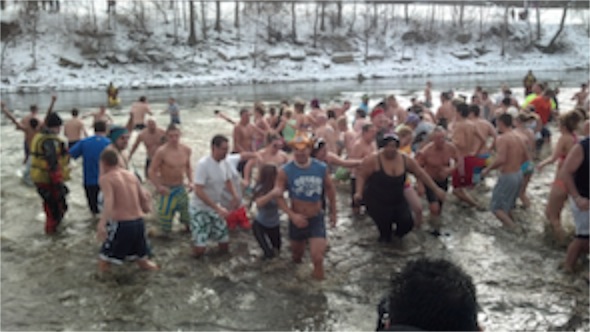
I suppose there is something symbolic about plunging into the water as a way of making a fresh start. We use water to cleanse our bodies and to clear our minds. Swimming has long been recognized as a healthful way to keep physically fit. And there is definitely something about plunging into cold water that focuses your attention and gives you a sense of being alive.
There are probably ancient traditions of taking a swim to celebrate a new year, but the popularity of such activities seems to be largely a 20th Century phenomena. The Boston event dates back to 1904. The plunge in Vancouver, British Columbia began in 1920. The big Nieuwjaarsduik in the Netherlands dates back only to 1960. In Finland, folks claim to have been dipping into icy waters for centuries, but the tradition is part of a wider Northern European tradition of becoming super heated in a sauna and then plunging into cold water to rapidly cool afterward.
Winter swimming may contribute to better health, or at least to a sense of well-being. People who suffer from rheumatism, fibromyalgia and asthma have all reported that winter swimming relieves pain. There are claims that it improves memory, raises moods and makes people feel more energetic.
But you have to admit that the idea does sound a bit crazy. Just because it is the most vigorous of people who take the plunge doesn’t mean that their vigor is caused by the dip into the icy water. I didn’t give it a try, so I guess I have no particular expertise. I’ve been known to turn off the hot water in the shower from time to time just to feel the sensation of the cold against my skin. It really wakes me up and reminds me of the luxury that surrounds me every day. But I don’t linger under the cold stream. I’m quickly reaching for the faucet to turn up the temperature or for my towel to dry and get dressed for the day.
What I do know is that there is an eagerness for new beginnings. People want to believe that something new is possible – that they are not stuck in the way things have been. People want to believe that problems can be solved, that they can make a fresh start, and that the way things have been is not the way they will always be. A New Year represents the possibility of a new direction for lives. In the church we use the water of baptism as a symbol for our belief that things can change and that we can make new beginnings. God continues to create and the way things appear now is not the final word on the meaning of life.
The contrast of looking at pictures of New Year’s Day revelers taking the icy plunge and the pictures of legislators in their suits and ties negotiating deals on (or over) the fiscal cliff was striking as I took a look at the news this morning. Although there is some relief that a deal was struck and that some of the worst possible effects of inaction have been temporarily averted, there is very little sense that our elected officials have shown either good judgment or leadership in the past few weeks. There has been far too much grandstanding and game playing for most of us to stomach.

Then, on January first, after having taken the plunge, they could all start over and work on fresh solutions to our shared problems.
Who knows? Polar plunges are often used as fund-raisers and our elected officials seem to be particularly adept at raising funds.
The idea probably won’t catch on, but it’s a thought.
Copyright © 2013 by Ted Huffman. I wrote this. If you want to copy it, please ask for permission. There is a contact me button at the bottom of this page. If you want to share my blog a friend, please direct your friend to my web site.
2013

I was born in 1953. That means that each time the year ends with the digit three I begin another decade. The half decades for me end with the digit 8. There have been plenty of significant events in my life that have occurred in years ending with 3 or 8. We were married in 1973. Our daughter was born in 1983. I completed my doctorate in 1978. We were ordained in 1978.
Of course there have been plenty of significant events that occurred in years that ended with other digits. Our son was born in 1981. We moved to the Black Hills in 1995. Our Australian sabbatical occurred in 2006. Each of the ordained ministers serving our congregation lost a parent in 2011.
Still, the years when my age ends with a zero or a five seem to be significant years to me. Back when I was in college, before I was married, I drew up a sort of a list of goals with one significant life event for each five years. I was not yet twenty, and my inexperience showed in many ways in the list. The goals were extremely ambitious. They were focused almost entirely on my professional career. They assumed that there was a “ladder” to climb. And they failed to take into account significant things that happened in my life. I achieved the goal for age 20 (top of my class in GPA). I made the goal for age 25 (complete my D.Min.). I have not yet achieved the goal I set for 30 (published as sole author of a book). I was late in achieving the goal for age 35 (senior minister of a multiple staff congregation). That took me until I was 42. I suspect that I will never achieve some of the things on the list. I have no particular desire to be a Conference Minister or to head an instrumentality in the church’s national setting. The list stopped at age 50. I didn’t. The list had no goals for retirement. It looks possible that I might live beyond retirement age.
What is striking to me about the list is the things that are so important to me that never made the list. I didn’t put anything about children on the list. Being a father is one of the deepest blessings of my life. I can’t imagine my life without it. I wouldn’t trade being a father for all of the success and recognition in the world. I didn’t put becoming a grandfather on the list, either. Although it is hardly an accomplishment that I have done, it is a wonderful part of my life. The list doesn’t address the success of the congregations that I serve. It doesn’t speak of growth or balanced budgets or grassroots mission or welcoming new members. It doesn’t mention capital funds drives or mission events or relationships with sister congregations.
It turns out that the list of goals hasn’t been very important to my life.
It turns out that goal setting and planning haven’t been very important in my life.
You can’t plan for the Grace of God. You can’t plan for faithfulness and obedience to God’s call. Moses didn’t plan to lead Israel out of slavery in Egypt. Jeremiah didn’t plan to be God’s prophet in a time of exile and return. Paul didn’t plan to become the voice of the expanding church. I’m no Moses or Jeremiah or Paul. But I have experienced God’s grace.
There is nothing in the world like experiencing the Grace of God when someone hands you an infant to care for and love. There is nothing in the world like experiencing the Grace of God when life hands you an unforeseen opportunity and you move in a direction that you never thought you’d go. There is nothing in the world like experiencing the Grace of God when a congregation really understands that it exists to serve others, not just to build up its own success in the eyes of the world. There is nothing in the world like experiencing the Grace of God in the understanding that this world doesn’t run on my achievements and sometimes I am privileged to be a part of something much bigger than myself.
Over planning might eliminate surprises. But the surprises are the best part of life.
It has been more than four decades since I made the list. I haven’t kept it. I don’t even remember all of the things that were on the list. I doubt that I will become a nationally or internationally recognized expert on anything. I probably still have a somewhat over-inflated ego, but I don’t seem quite so brazen as I was in those days.
So I begin 2013 with modest resolutions. I resolve to continue to lose a bit of weight and become a bit more fit so that I am a wise steward of my own health. In doing so I hope that I will have a bit more energy for family and for service in the church. I resolve to look for the best in the people that I find challenging and difficult and to ask myself, “What is best for this person?” when I am moved to anger.
I don’t expect 2013 to be a year of major transitions in my life. I hope that I can be faithful in serving those who do experience changes of career, loss of loved ones, moves to new locations, and other life-changing events. If there is honor and recognition, I pray that it will come to the colleagues with whom I am privileged to work and to the congregation I am privileged to serve. More than that, I hope that we remember to give God the glory and honor and wonder and power.
I’ll celebrate birthday number 60. My beard has become the right color for the age. I’ll celebrate wedding anniversary number 40 – when I tell young couples of the joy of growing old together, I know the truth of which I speak.
And that will be enough. As I have learned that the years pass, so too do the decades. There will be more years that end with the digit 3 and right now it looks like I might be around for at least some of them.